Adventurous Kate contains affiliate links. If you make a purchase through these links, I will earn a commission at no extra cost to you. Thanks!
I absolutely LOVE traveling alone in the Balkans! After traveling to more than 80 countries and all seven continents, I always tell people that the Balkans are my favorite region on the planet. It’s the truth. I love it here more than anywhere else.
I love the Balkans because they’re zany and beautiful. They’re weird, they’re lovely, and they’re quite affordable compared to Western Europe. The Balkans are summertime personified.
A lot of people hear about a woman traveling alone in the Balkans and wonder, “Are the Balkans safe?” For a woman traveling solo, and for people in general? Is Bosnia safe to visit these days? What about Kosovo?”
Yes. Today, the Balkans are a very safe place to visit. While there have been conflicts in the Balkan countries in the last 30 years, today they are a safe place to travel, even for women traveling alone. Traveling the Balkans is very similar to traveling elsewhere in Europe.
I’ve written this detailed guide so you can enjoy my favorite region in the world to the fullest. This is full of tips I’ve acquired over several years of Balkan exploration. It’s time for you to get planning!
This post was last updated in January 2020.
Table of Contents
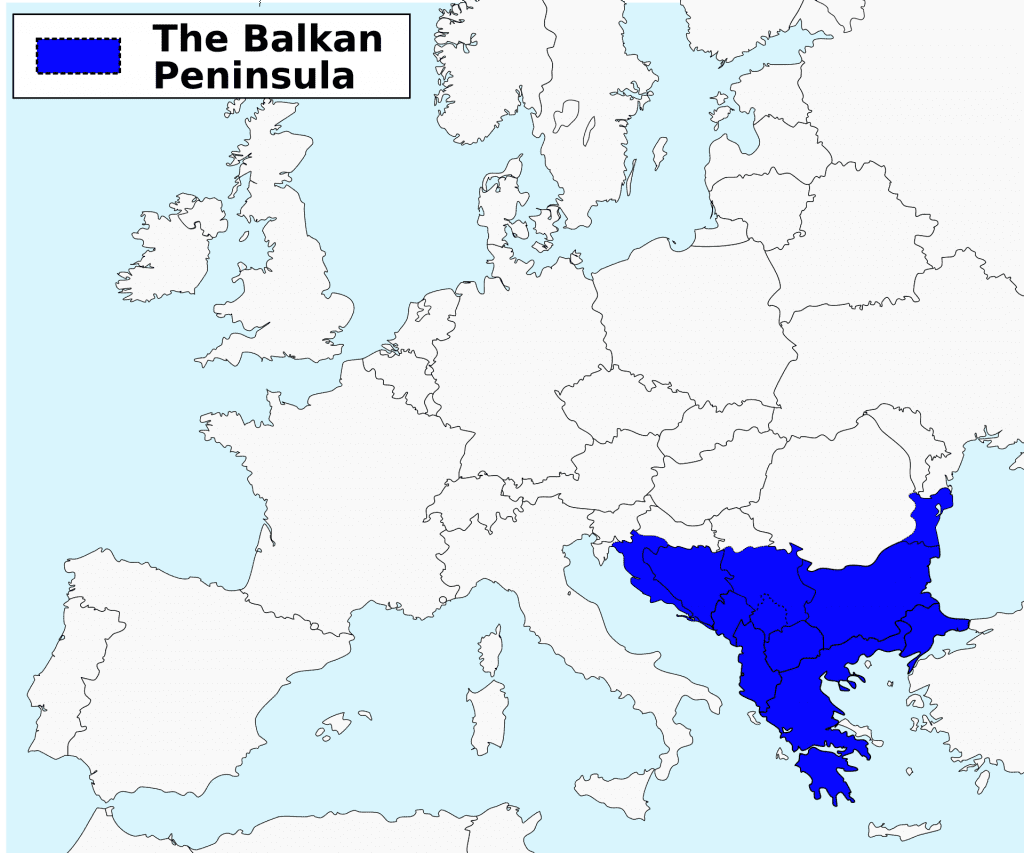
Where Are the Balkans?
There are lots of definitions over what parts of Europe are considered “the Balkans.” Some definitions are geographic and others are political. See one of the iterations in the map above.
Generally, “the Balkans” refer to countries surrounding the Balkan mountain range in Southeast Europe: the countries of the former Yugoslavia (Slovenia, Croatia, Serbia, Bosnia and Herzegovina, Montenegro, Kosovo, North Macedonia) as well as Albania, Greece, and Bulgaria. Sometimes parts of Romania, and Turkey are included; sometimes parts of Slovenia, Croatia, and Serbia are excluded.
However, when travelers speak about the Balkans, they’re generally referring to the Western Balkans — everything west of Bulgaria and Romania and north of Greece.
For the purposes of this guide, I’m covering the Balkans as the countries of the former Yugoslavia (Slovenia, Croatia, Serbia, Bosnia and Herzegovina, Montenegro, Kosovo, North Macedonia) and Albania.
Why Travel Solo to the Balkans?
If you’ve done London and Paris, spent time in Italy and crossed Spain by train, and you’re ready for something different and offbeat, the Balkans are where to go next! They are great countries in which to travel solo, and there are a million kinds of trips you could plan in the Balkans.
Here are the best reasons to travel to the Balkans:
A quirky region in the heart of Europe. The Balkans break the rules. Here you’ll find wild, art-filled cities with strange architecture, fascinating traditional villages, funky brass bands, unusual wines, and proud people who are convinced that you’ve come to the best place on the planet.
Bright neon lakes, rivers, and waterfalls. In this part of Europe, the lakes and rivers are often brightly saturated — shimmering neon turquoise, teal, and emerald green. From the river in Mostar to the waterfalls of Krka National Park to the Bay of Kotor to Lake Bled, you’ll love the bodies of water here.
An outstanding cafe culture. One of my favorite things about the Balkans — they love their cafes! And whether it’s Ljubljana, Slovenia or Bitola, North Macedonia, there are streets packed solid with cafes. You get coffees during the day, cocktails at night, and the cafe streets are the place to see and be seen at sunset.
Spectacular coastline. Croatia may have the most famous coastline in the Balkans, but Montenegro and Albania are also home to stunning beaches. Bosnia and Slovenia have blink-and-you’ll-miss-it coasts, too. The coastline in this part of the world is rocky, not sandy, and the water is edged with orange-roofed villages.
Value for money. For the most part, the Balkans give you excellent value for money compared to Western European destinations. Dubrovnik is the most expensive destination in the Balkans by far, but almost everywhere else is significantly cheaper.
The cheapest countries in the Balkans are Albania and Macedonia, and Kosovo, Bosnia, Serbia, and inland Montenegro aren’t far behind. Croatia and Slovenia are priciest and Montenegro’s coastline around Kotor and Budva is inching up there.
Like anywhere else in the world, cities and coastal resorts are more expensive while rural, inland, less-popular areas are cheaper.
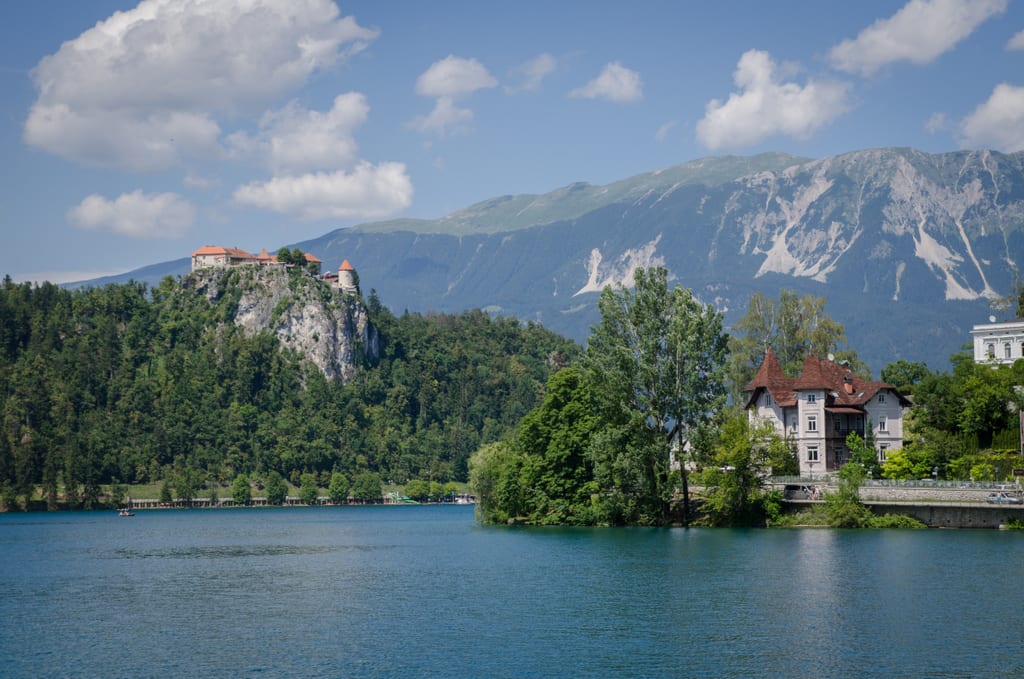
Are the Balkans Good for First-Time Solo Female Travelers?
I think two countries in the Balkans are excellent choices for first-time solo female travelers: Croatia and Slovenia. These two countries are the most developed of the Balkans and both are well-outfitted for first-time solo travelers who don’t have a lot of travel experience. Both countries have great travel infrastructure and English is widely spoken.
You can read my full solo female travel guide to Croatia here.
If you’re traveling to Dubrovnik in Croatia, you may want to visit Mostar in Bosnia and Kotor in Montenegro, which are both popular day trips from Dubrovnik. I think these two destinations would also work well for first-time solo female travelers. Both have good travel infrastructure and are easy, beautiful towns to visit. (Don’t day trip, though — they’re better if you stay overnight.)
Beyond that, the Balkans get more challenging. Bosnia, Montenegro, and Serbia are less developed than Croatia and Slovenia, and I think they’re better suited for first-time solo female travelers who already have good travel experience and just haven’t traveled solo before.
Albania is the most difficult country in the Balkans to travel, due to the odd transportation system and strong language barrier, and I don’t recommend it for first-time solo female travelers. North Macedonia and Kosovo aren’t quite as challenging as Albania, but I think they’re both more suited to more experienced travelers.
Balkans Tours for Solo Travelers
If you’re not quite sure if you’re ready to travel completely solo, another option is joining a group tour! G Adventures is a company with whom I’ve traveled before and I recommend. Their tours are very solo-friendly, they keep their groups small, they’re sustainability-minded, and they have several tour options in the Balkans.
Here are some of them:
- Zagreb to Athens: Adriatic & Ancient Capitals (15 days, Zagreb to Athens) — From Zagreb to the Plitvice Lakes, Croatian coast and islands, Montenegro and Albania beach towns, finishing in Greece.
- Croatia and the Balkans (15 days, Budapest to Split) — From Budapest to Novi Sad and Belgrade in Serbia, followed by Sarajevo and Mostar in Bosnia, the Bay of Kotor in Montenegro, and Croatia’s islands and beaches, finishing in Split.
- Discover the Balkans (12 days, Zagreb to Dubrovnik) — This National Geographic Journey focuses on deep cultural experiences in Croatia, Bosnia, and Montenegro.
- Sailing Croatia: Split to Dubrovnik (8 days, Split to Dubrovnik) — Eight days of sailing Croatia’s islands and beaches between Split and Dubrovnik.
- Dalmatian Coast & Montenegro Sailing (15 Days, Split to Dubrovnik) — 15 days of sailing the beautiful coastlines of Croatia and Montenegro.
- See all of their tours in the Balkans here.
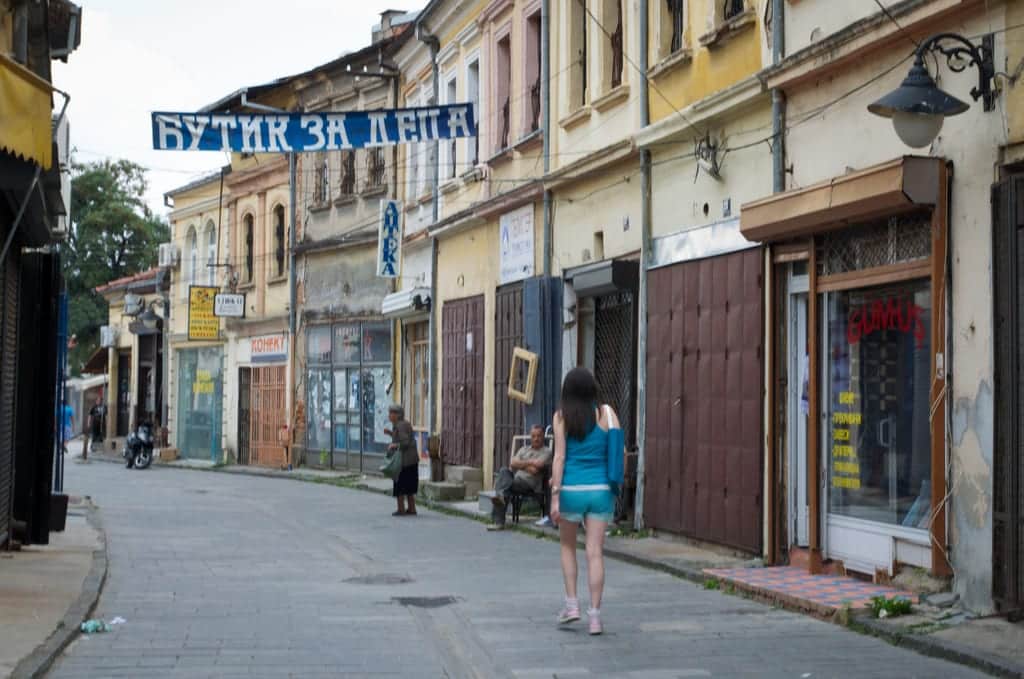
Are the Balkans Good for Experienced Solo Female Travelers?
Yes, yes, absolutely yes. I visited all of the countries of the Balkans over a period of several years, and I’ve only fallen more in love with the region. I did start in some of the easier spots (Croatia, Bosnia, coastal Montenegro) and worked my way up to Albania over time.
You can enjoy every single region in the Balkans as an experienced solo traveler and there are no places that I would avoid outright. There is one place where I would plan my time carefully, though: Dubrovnik, due to its mass overtourism. You can read my Dubrovnik Survival Guide to figure out how to enjoy the city while avoiding the worst crowds.
Beyond that, I feel that offbeat inland Balkans destinations like Bitola in North Macedonia, Prizren in Kosovo, and Sarajevo in Bosnia will be far more appreciated by women who have more travel experience. As for Albania (oh, Albania…), this country is fascinating and weird and difficult and incredibly beautiful and ugly at the same time. I would never send a newbie traveler there, but it is an absolute treat if you’re an experienced traveler.
Whether you want to island-hop in Croatia or party at a music festival in Serbia, whether you want to hike the mountains of Montenegro or gape at the weird sculptures of Skopje, the Balkans are anything but boring.
Are the Balkans Safe?
Generally speaking, the Balkans are as safe as your hometown — or perhaps even safer. There are two major misconceptions that portray the Balkans as dangerous.
First off, the Balkans are not at war anymore. They are safe to visit. I find that 90s conflicts tend to cast a long shadow, and many people assume that South Africa is still reeling from post-Apartheid violence, Pol Pot is still destroying Cambodia, Medellín is still a cartel-controlled danger zone, Bosnia is still at war, and bombs are still falling in Kosovo. None of these have been true for 20 years.
Still, remember that many locals in the Balkans are living with trauma, and the scars of war are visible. You see bullet holes on buildings in Sarajevo and Mostar to this day. Albanians and Serbs can’t stand each other. And don’t mention the word “Kosovo” out at a bar in Belgrade or you might be faced with stony silence. Keep this in mind when you speak with locals.
Secondly, Taken is not real. Unfortunately, that Liam Neeson movie did a lot more to color people’s preconceived notions of the Balkans, and Albania in particular, than decades of good press. More seriously, it amplified fears that young women traveling Europe on their own will be kidnapped and sold into sexual slavery.
The movie came out in 2008, before I was blogging full-time about solo female travel, but as an avid traveler, it pissed me off. It fanned the alarmist fears about travel that dominate the American media — the myth that a woman would be crazy to travel anywhere without a man by her side.
Take Taken for what it is — entertainment, not reality.
The truth? Traveling in the Balkans is similar to traveling the rest of Europe, though things are slower and less-developed here. Your biggest risk when traveling solo in the Balkans is petty theft, just as it is in the rest of Europe, and you’re less likely to get pickpocketed here than in Paris or Barcelona.
Most safety precautions in the Balkans come down to common sense — it’s about keeping an eye on your belongings, locking up your valuables in your accommodation, watching your drinking, and not trusting strangers too quickly.
Read More:
Top 10 Travel Safety Tips for Women
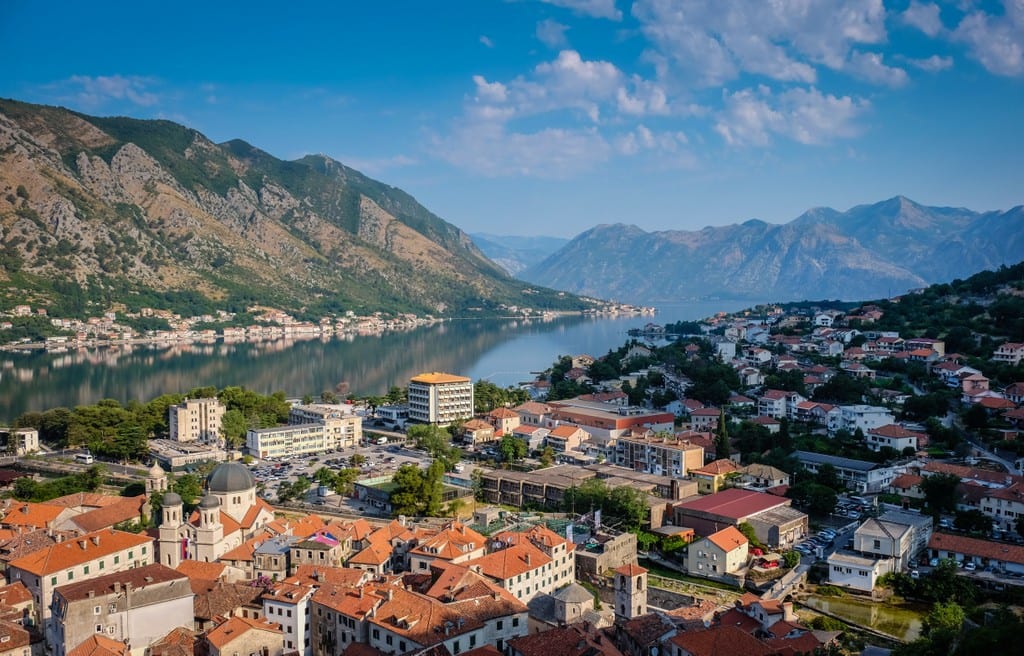
Where to Go in the Balkans
The countries of the Balkans are chock full of interesting attractions. You could spend six months in the region and still wish you had time to see more. I encourage you to spend longer in a smaller region within the Balkans rather than trying to hit up every country.
If you love cities, the Balkans have plenty. My favorites are Ljubljana, for the perfect fairy-tale ambiance and architecture; Belgrade, for the layered history and crazy nightlife; Sarajevo, for so many cultures existing in one place; and Tirana, for the sheer weirdness and cheapness of it all.
If you love beaches, focus on Croatia and Albania. Keep in mind that the beaches here are rocky. Rent a car in Albania to see the best beaches, concentrating on the area around Ksamil and Drymades. Some of the nicest beaches in Croatia are just south of Dubrovnik and on the islands of Hvar and Brač. Zlatni Rat on Brač is a rare sandy beach in Croatia. You can’t beat the view from the beach in Sveti Stefan, Montenegro!
If you love small cities, this is one of the Balkans’ greatest strengths. There are so many interesting small cities here. Mostar in Bosnia is gorgeous and has a sad, moving history; Prizren, Kosovo, is a pretty little town that defies all preconceived notions of the country; Ohrid, North Macedonia, is fun little city on a gorgeous lake. My all-time favorite small city in the Balkans, however, is Zadar, Croatia, a small seaside enclave that is quirky and relaxing in all the right ways.
If you like natural wonders, go deep into nature. The Plitvice Lakes in Croatia are justifiably famous for their waterfalls (though don’t miss Krka National Park too), Slovenia’s Skocjan Caves are spellbinding, and perhaps the most beautiful adventure activity is whitewater rafting through Tara Canyon on the edge of Montenegro’s spectacular Durmitor National Park.
If you like going off the beaten path, there are lots of cool options. If you like cool smaller cities that don’t get a lot of attention, I really like Bitola in North Macedonia, Idrija in Slovenia, and Berat in Albania. For nature sights, consider Kravice Falls in Bosnia and Slavonia, the region of northeast Croatia that gets far fewer visitors than the coast.
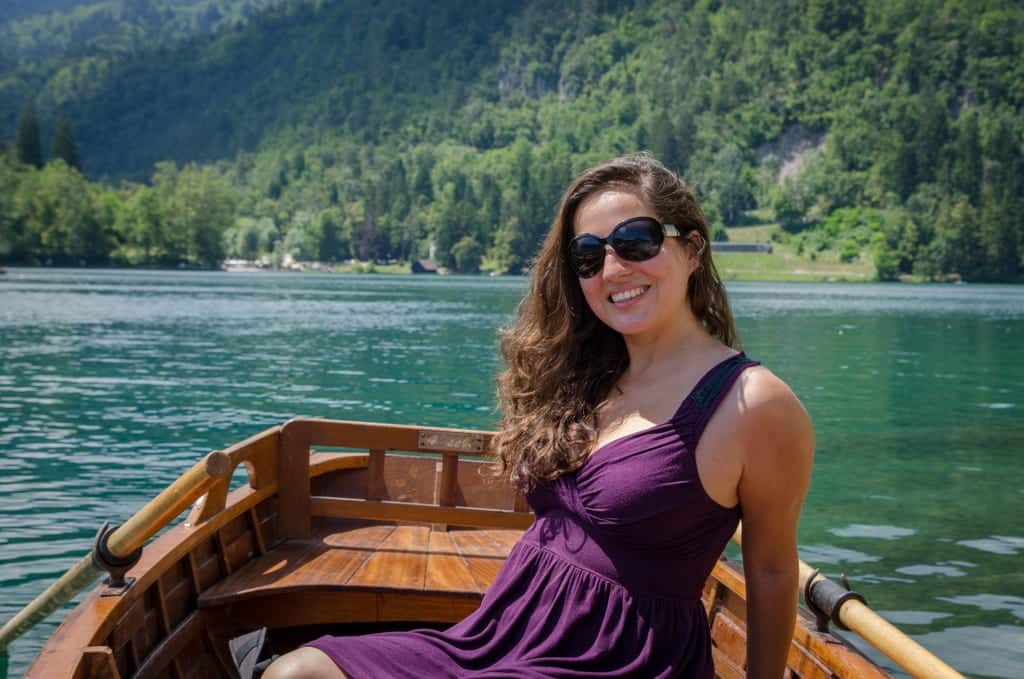
Solo Female Travel in Slovenia
Of all the Balkan countries, Slovenia is the country that feels the least like the others. Part of this is due to the fact that the Balkan mountain range runs through the middle of the country. Northern parts of Slovenia like Bled feel much more like Austria, while southern parts of Slovenia like Piran feel more like Croatia.
Slovenia is among the most developed countries in the Balkans and it’s very easy to travel here. Slovenia makes a great “gateway Balkan” — if you’ve already traveled in the more popular countries of Europe, Slovenia could be a great choice for you.
I think Slovenia is a perfect option for first-time solo female travelers because it’s so easy, it’s so safe, and it’s so beautiful. When you factor in all the variety in Slovenia, from arts to urban life to adventure spots to nature, to you can figure out what you enjoy best and plan your future solo trips better.
I feel like Slovenia would have triple the visitors it gets if people realized just how charming it is. It has so much natural beauty and easy access to outdoor adventure, but due to its small size, you can do an extensive road trip of the country in just 5-7 days. I recommend exploring Slovenia by car if you can; you’ll see much more this way.
One last thing: Slovenia is the only Balkan country that is part of the Schengen Area, so be cautious if you’re coming up on your 90-day limit of time in the Schengen Zone.

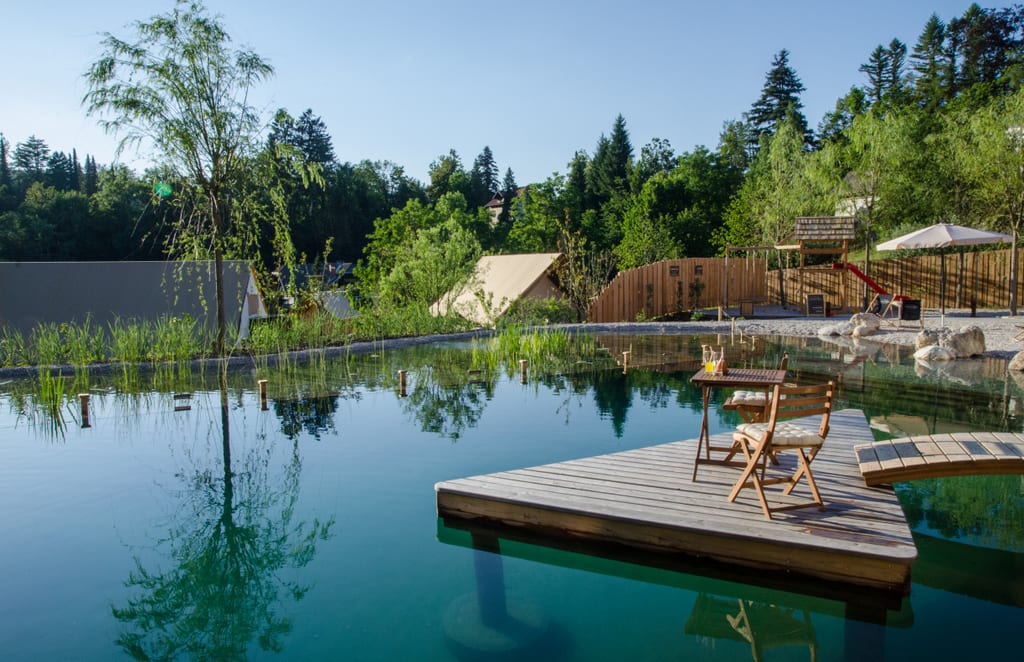
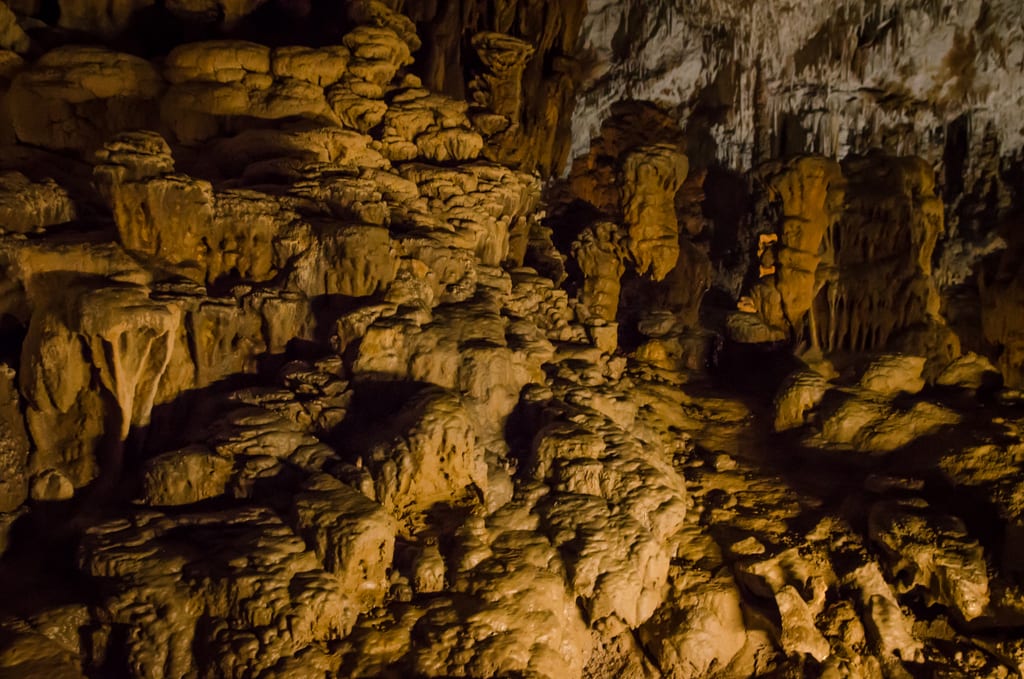
Best Things to Do in Slovenia
Attend the Ana Desenica Festival in Ljubljana. This street theater festival takes place in June every year and it’s absolute magic — performances and dancing and magic and music, many of the shows involving bystanders if you want to take part. It’s like the Edinburgh Fringe Festival, but cheap.
Sleep in a treehouse in Bled. One of my favorite places I have ever stayed was Garden Village in Bled, close to Lake Bled. This sustainable resort has treehouses where you can stay, tables covered with real grass, and a bright turquoise natural pool.
Explore a mercury mine in Idrija. Deep in the ground are mines filled with a metal so dense and heavy, it will shock you when you pick it up.
Row a boat across Lake Bled to the island. Lake Bled doesn’t allow motorized boats, which adds to the charm and keeps things quiet. Get yourself to the island using your own body power!
Explore the Skocjan caves. You may think that you know what you’re getting into — but the Skocjan caves are even bigger and deeper than you think they’re going to be.
Eat žlikrofi and drink black wine. Slovenian food doesn’t get a lot of international attention but these ravioli-like dumplings wash down beautifully with Slovenia’s darkest reds.
Spend a quiet weekend on Lake Bohinj. Whether you are a camper or prefer something with an actual roof, this is a peaceful lake away from the craziness of Bled.
Get professional photographs taken in Slovenia. Professional photos of me on my travels are my absolute favorite souvenirs! Whether for Instagram or a professional portfolio, they are priceless. Flytographer offers packages with professional portrait photographers around the world, and they operate in Ljubljana.
Read more about Slovenia:
Ana Desenica: Ljubljana’s Incredible Street Theatre Festival
The Ultimate Slovenia Road Trip
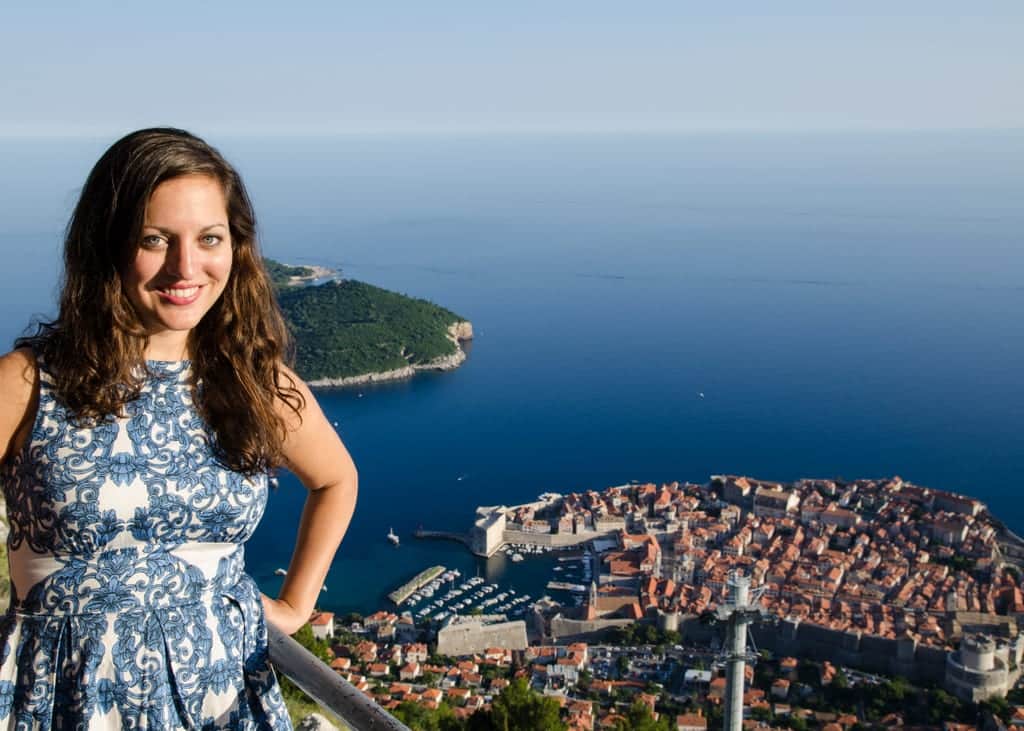
Solo Female Travel in Croatia
Croatia is one of my favorite countries in the world, and I’ve already written a solo female travel guide to Croatia that goes into more depth than this post. A lot of people aren’t sure how it will be to travel in Croatia, especially North Americans, but I think it’s a great choice for women who have never traveled solo, ever!
Croatia has the best travel infrastructure of all eight countries in the Balkans. As a result, it’s a very popular travel destination. Croatia is where you’ll see the most tourists in the Balkans, and Dubrovnik is the only place in the Balkans with major overtourism problems during the summer months.
One common mistake I see is people assuming that Croatia will be cheap because “it’s Eastern Europe” (cringe). Croatia can be cheap if you stick to rural inland towns, like Grožnjan, and beach spots for locals, like Makarska, but Dubrovnik can be extremely expensive and places like Rovinj and Hvar aren’t far behind.
There is one popular spot in Croatia where I don’t recommend spending as much time: Split. While I really enjoyed wandering Diocletian’s Palace, I find that Split tends to be overrun with tourists and the businesses that cater to them. My recommendation? Don’t make Split a base. Instead, arrive in the afternoon, check out the palace, hit up a wine bar, stay overnight, and leave for an island the next morning. Zadar is nearby and makes a much better base than Split.
My other top recommendations in Croatia are to road trip if you can (roads here are GREAT), and spend some time exploring the islands.
Finally: there is no train to Dubrovnik. There are some train routes in Croatia but you’ll need to take a bus to Dubrovnik. More on that below in the transportation section.
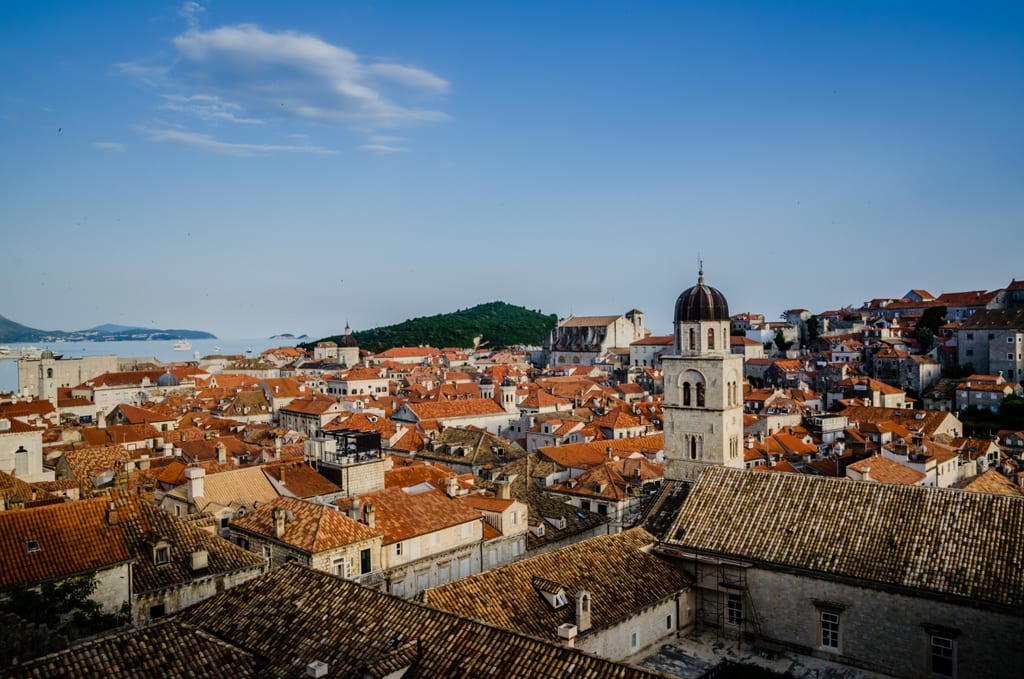
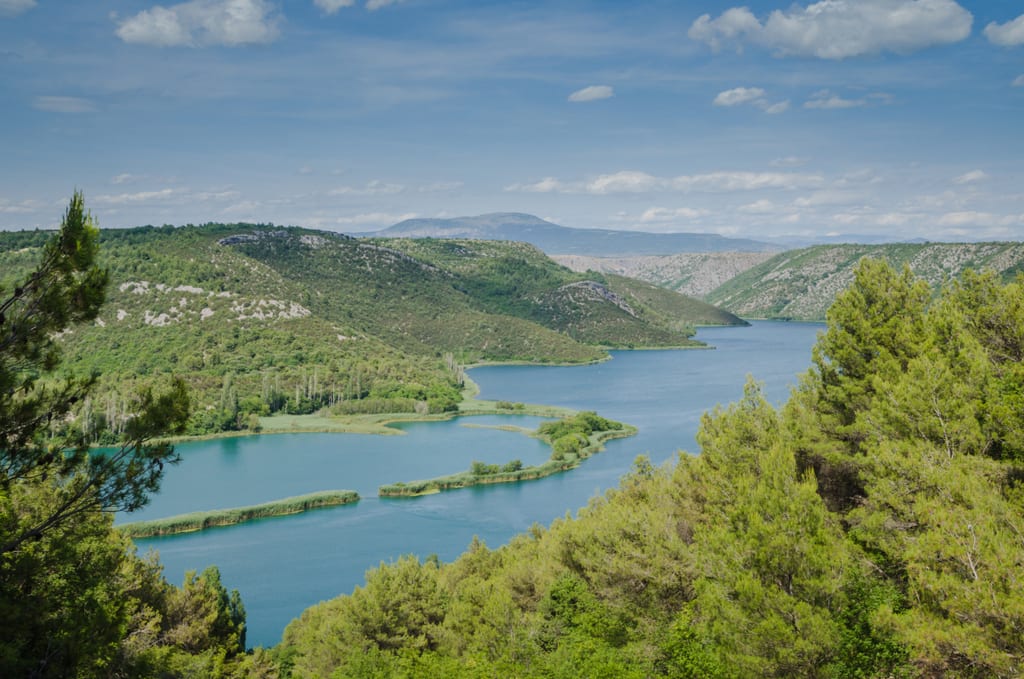
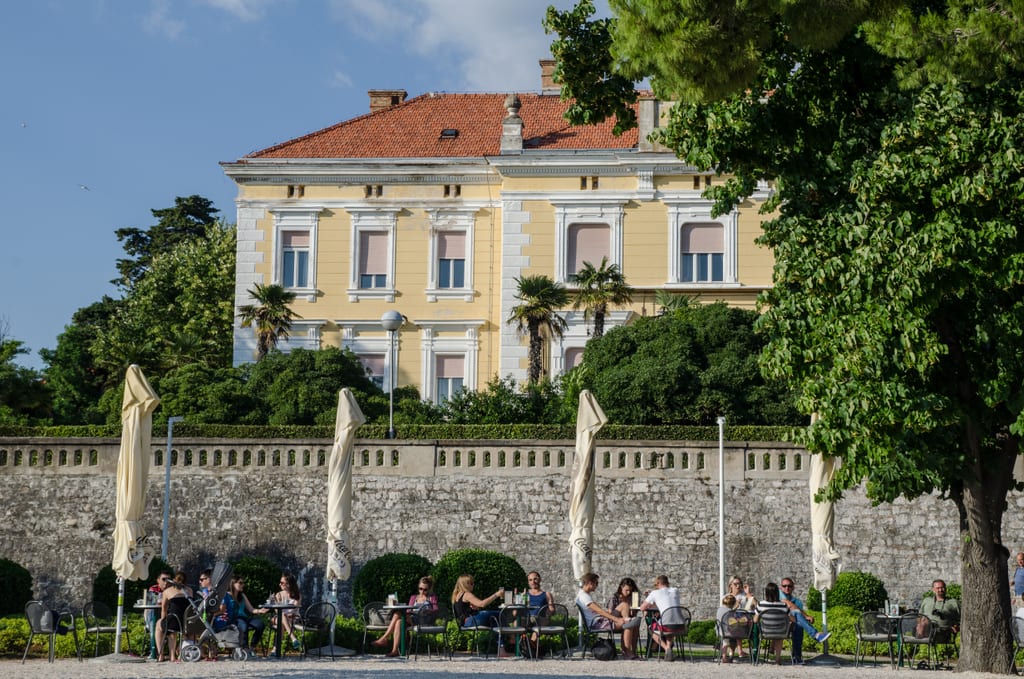
Best Things to Do in Croatia
Visit the Museum of Broken Relationships in Zagreb. This may be my favorite museum on the planet. It’s a collection of items that people donated from their past relationships, along with the sad, sweet, and funny stories behind them.
Swim in the saltwater lakes of Mljet. This island is my favorite day trip from Dubrovnik, home to a national park and some neon green saltwater lakes. Perfect for a swim.
Go waterfall-chasing at Plitvice Lakes and Krka National Park. Croatia is famous for its waterfalls and these are the two best spots to see them. The Plitvice Lakes has more waterfalls but you can actually swim in the water near the falls at Krka!
Listen to the Sea Organ in Zadar. One of Zadar’s unusual attractions is an organ that makes music with the waves of the sea. Sit on the ledge, look out at the water and listen to the soft music.
Road trip through Istria. One of my favorite places in the Balkans to road trip is the Istrian peninsula, which is filled with beautiful small towns and feels like Italy in a lot of ways. You can get truffle dishes here for super-cheap.
Go on a Game of Thrones tour in Dubrovnik. This city was used as King’s Landing in the series, and lots of locals served as extras. Some of those extras are now serving as guides! My favorite part was looking at stills from the show and comparing them to real life. You can book a Game of Thrones tour here.
Sail through the islands. Whether you book a weeklong sailing trip or just do a day of sailing, this is one of the most beautiful countries in the world to explore by sailboat.
Get professional photographs taken in Croatia. Professional photos of me on my travels are my absolute favorite souvenirs! Whether for Instagram or a professional portfolio, they are priceless. Flytographer offers packages with professional portrait photographers around the world, and they operate in Dubrovnik and Zagreb.
Read more about Croatia:
Solo Female Travel in Croatia: The Complete Guide
Destination Guides: Dubrovnik, Korčula, Vis, Rovinj, Istria, Zadar, Krka NP
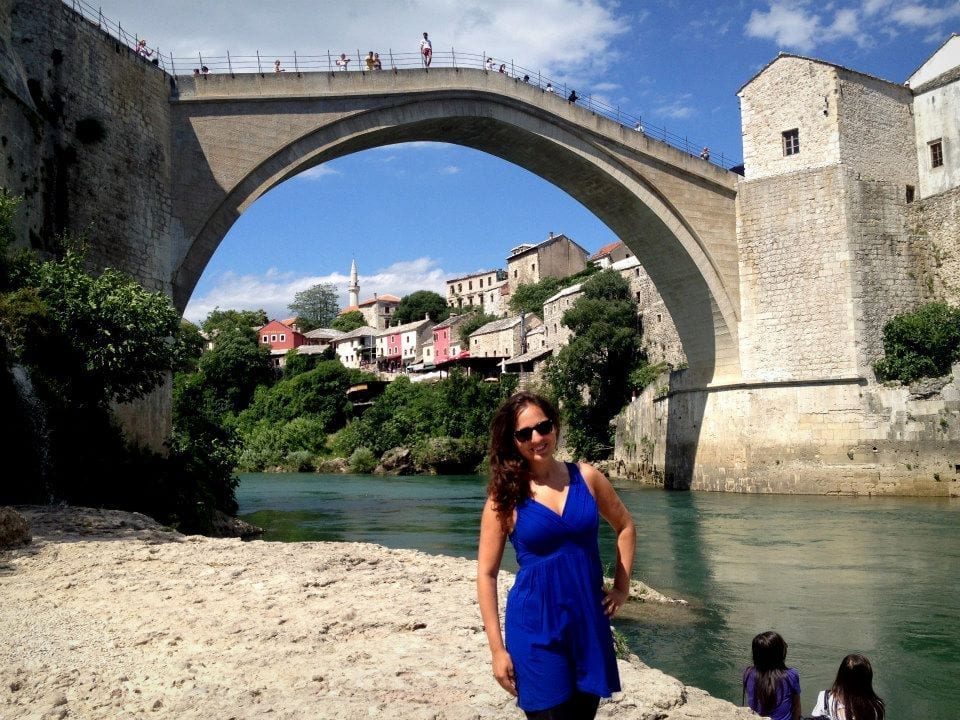
Solo Female Travel in Bosnia
Bosnia and Herzegovina was the second country I ever visited in the Balkans, and I think it’s one of the most culturally interesting destinations in the region. Though it’s known for having one of the most painful recent histories of the Balkans, today Bosnia is a beautiful and fascinating place to visit.
Is Bosnia safe to visit? Yes. This is the question that often comes up when discussing Bosnia, but the country has changed enormously since the war in the 1990s. There is one issue to be cautious about: there are still some unexploded mines in extremely rural areas. If you’re traveling to rural areas, stick to commonly trod paths or hike with a guide.
Aside from that, just take the normal travel precautions you’d take anywhere else. There is no bigger risk for solo female travelers here than anywhere else in the Balkans, or in Europe — with proper research and preparation, Bosnia can be a great destination for women traveling alone.
Travel in Bosnia can often be a bit rough and slow-going, and I recommend solo women travel by bus rather than by train. Some popular spots in the country like Kravice Falls are a bit of a pain to do by public transportation and are better done by joining an organized tour from somewhere like Mostar.
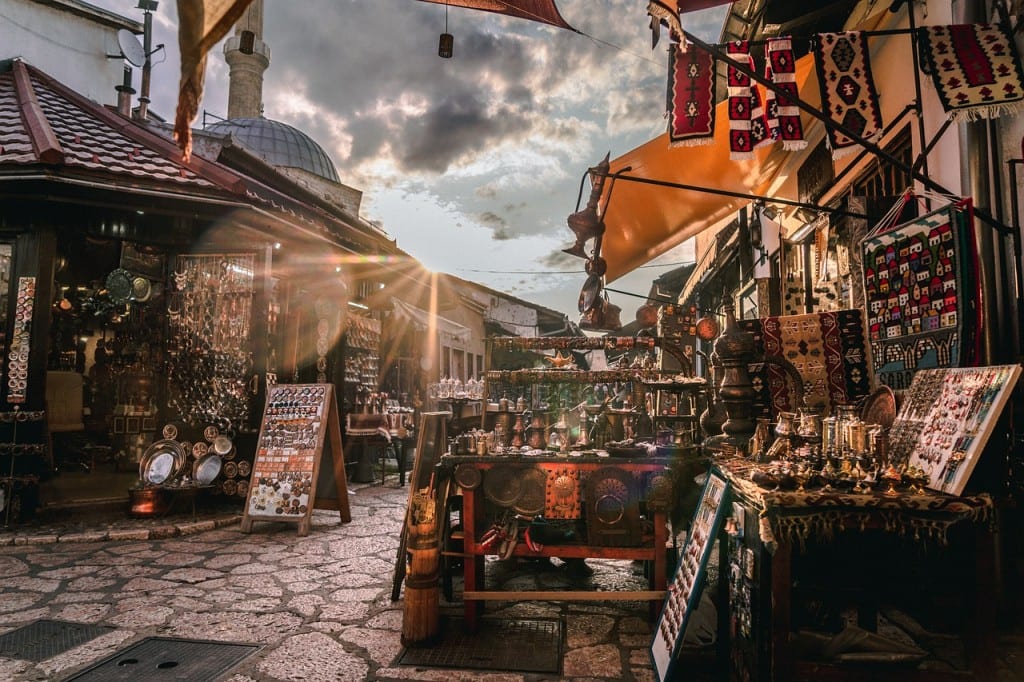
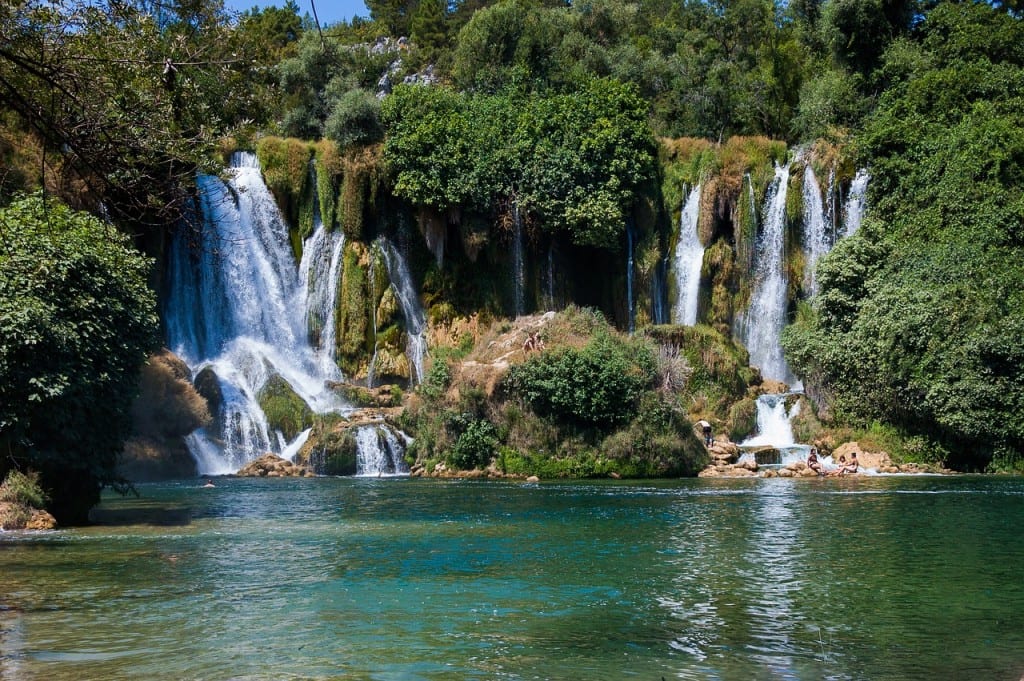
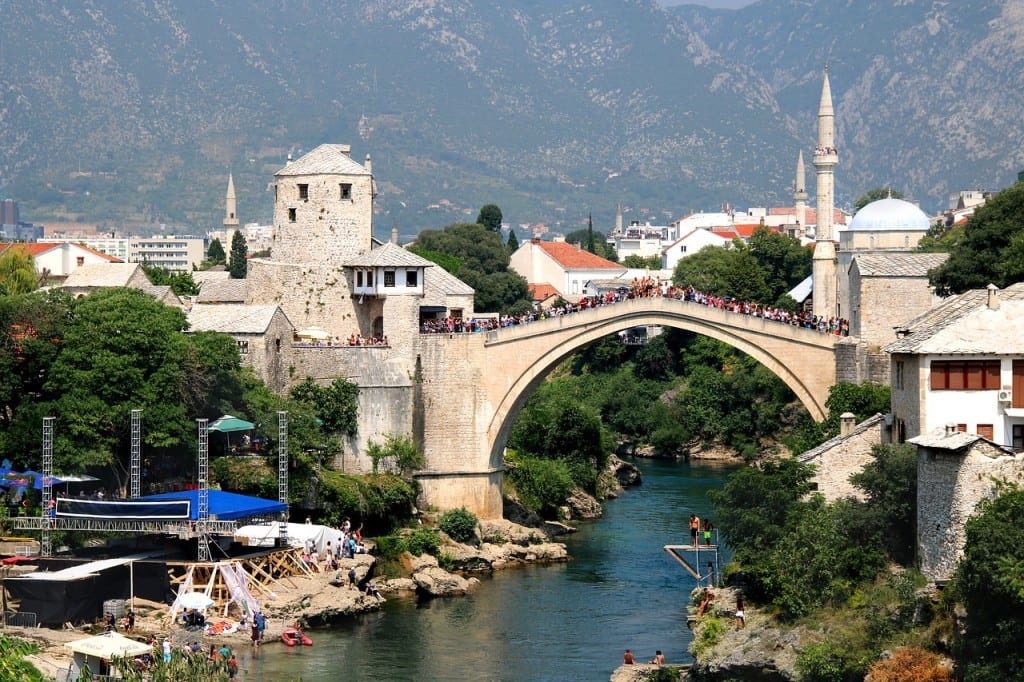
Best Things to Do in Bosnia
Take the historic tour of Mostar with Žika from Hostel Nina. This is the single most moving thing I did in Bosnia and I’m grateful I got to learn about the impact of the war on the locals. You won’t regret it, and you’ll love getting to know Žika.
Go Virgin Mary-crazy in Medjugorje. In 1981, the Virgin Mary reportedly appeared to six children in Medjugorje. Today, Catholic pilgrims flock to see the spot. While the sight itself is a bit of a letdown, the Virgin Mary-stocked souvenir shops alone are worth the visit.
See Kravice Waterfalls. These waterfalls aren’t as famous as their Croatian counterparts, but at 25 meters tall, they are enormous! The falls are a great place to spend an afternoon swimming and picnicking.
Eat lots of ćevapčići. This dish is found throughout the Balkans, but I enjoyed it in Bosnia the most: little beef sausages served with pita and onions.
Get lost in Sarajevo. This city is full of interesting corners to explore, from the Ottoman-era Baščaršija market to the tunnels running beneath the city to the Latin Bridge, where Franz Ferdinand’s assassination kicked off World War I.
Watch the divers jump off the Old Bridge in Mostar. This can be a hair-raising event to watch — but for many men in Mostar, jumping from this great height is a rite of passage.
See Bosnia’s blink-and-you’ll-miss-it Adriatic coastline at Neum. This town is a thorn in the side of travelers trying to travel down the Croatia coast and having to go through two rounds of immigration — but for people already in Bosnia, it’s a lovely seaside stop.
Ski the cheapest Olympic slopes in Europe. Bjelašnica is where Sarajevo’s Olympic ski events took place, and here you can find runs from easy to super-challenging for a fraction of what you’d pay in Western Europe.
Read more about Bosnia:
Life After War: Sarajevo Today
Mostar: A Beautiful and Heartbreaking City
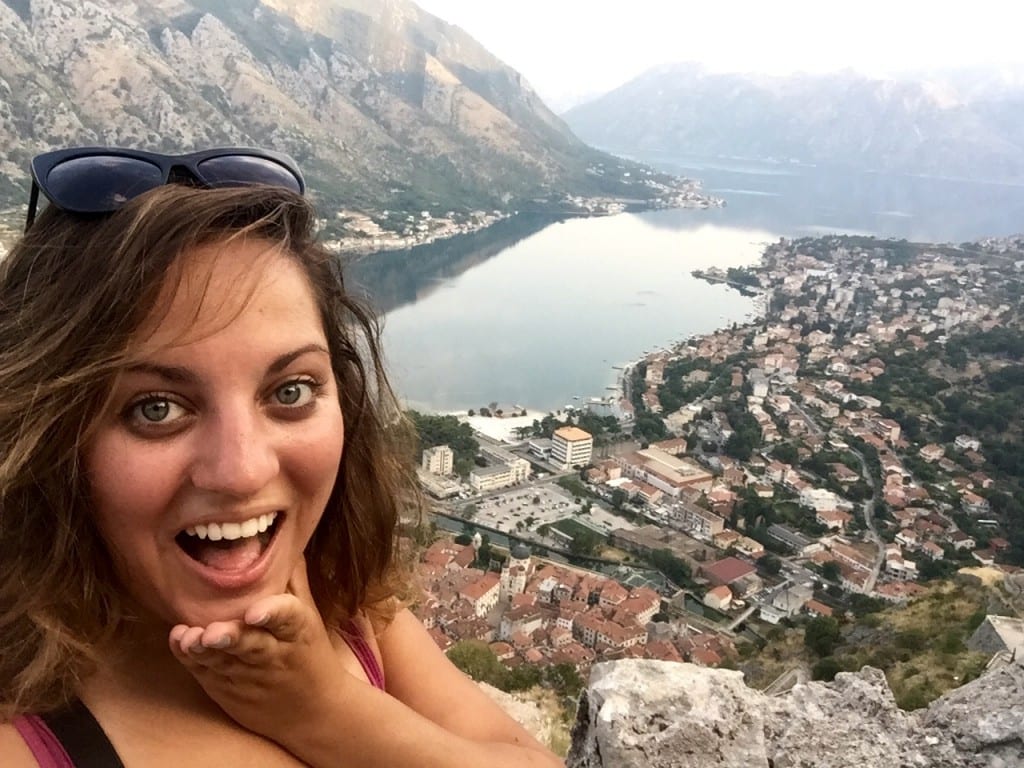
Solo Female Travel in Montenegro
I absolutely adore Montenegro and consider it one of my favorite countries. In fact, after traveling to every country in Europe, I think Montenegro is the most beautiful country in Europe. (Yes, I know, Switzerland and Norway are beautiful too. I said what I said.) Montenegro feels like what Norway would be if it were placed in a warm climate.
Montenegro has been touted as “the next Croatia” for quite some time — and it’s starting to have an effect. While Montenegro has historically been a holiday spot for Eastern Europeans (and in places like Budva, the crowd is still heavily Russian), the country is seeing increased tourism from North Americans and Western Europeans.
Kotor and the surrounding towns have long been a popular day trip from Dubrovnik, but Kotor is dealing with the beginnings of overtourism as a result of cruise ships. Staying overnight in Kotor is one way to experience the town at its best, when the sun goes down and everything becomes quiet.
I had no issues traveling solo in Montenegro, but know that the towns close to Croatia are much more developed than the rest of the country, and some buses don’t run as often as you’d hope. If you’re traveling solo for the first time, the public transit might drive you a bit crazy. I also found the driving in Montenegro to be wild at times.
If you’re traveling onward to Albania from Montenegro, I strongly encourage taking the shuttle to Tirana from Montenegro Hostel — it saves so much time and frustration.
On a trip to Montenegro, you’ll want to balance your time between coastal destinations and inland mountain destinations. Just try to soak up as much beauty as humanly possible. (One place that you can skip without guilt is Podgorica, the capital — you’re better off spending your time elsewhere.)
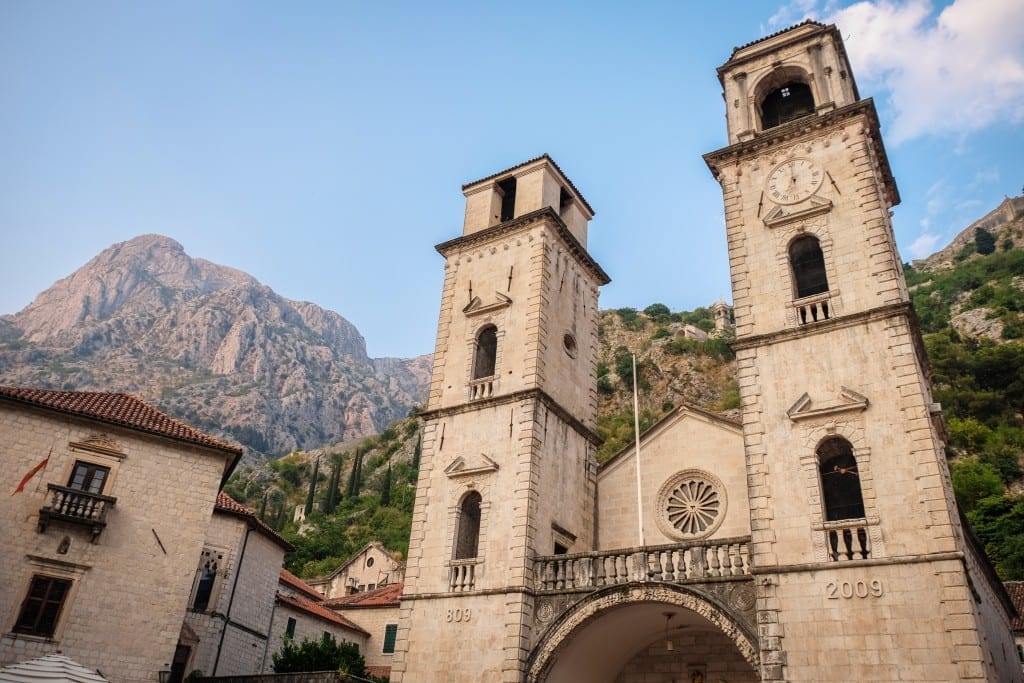
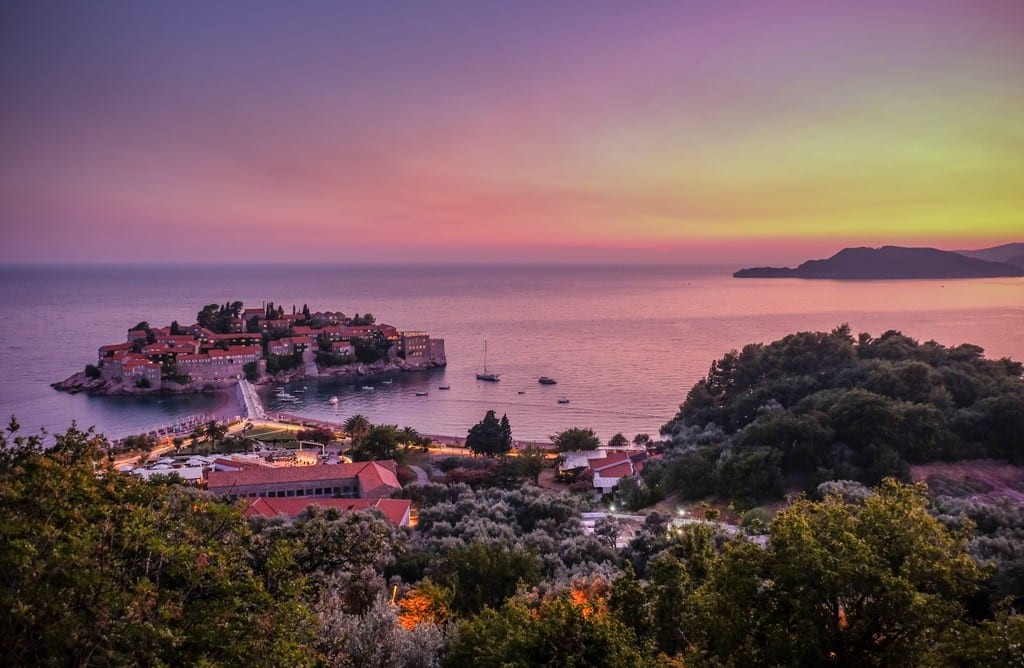
Best Things to Do in Montenegro
Hike up to the top of Kotor at dawn and watch the sunrise over the Bay of Kotor. By far the best activity to do in Kotor, one of my favorite places in the Balkans. The views are almost unspeakably beautiful, the colors change enormously, and if you do this during the summer, it’s nice and cool.
Check out Sveti Stefan. This town is home to a spectacular island off the coast that was once a resort for the Hollywood stars like Elizabeth Taylor, fell into disrepair during the war, then was turned into a luxury resort again. The resort is off-limits to non-guests but it makes a great photo stop. The beach has two sides: one expensive and for hotel guests, and the other is much cheaper.
Go whitewater rafting in Tara Canyon. This might be one of the most visually spectacular places in the world to whitewater raft. You speed down the jade-green river while surrounded by dramatic green and white mountains.
Dance on the beach at Sea Dance Festival in Budva. I am not ordinarily a concert-goer, but this music festival is one of the most fun things I have ever done in the Balkans — and you can’t beat dancing to EDM on a beach surrounded by mountains.
Explore Herceg Novi. This town close to the Croatian border is the gateway to the Bay of Kotor — but smaller and less touristed than Kotor, and home to some good swimming beaches.
Spend a few days exploring Durmitor National Park. This is one of the most beautiful places in the world most people have never heard of. A great spot to do some hiking, biking, and climbing the tallest mountains in Montenegro.
Take a boat across Lake Skadar. This lake in southern Montenegro, close to the Albanian border, is home to unique bird species. Cruise across the lake, explore the wetlands, and spend time in the lakeside villages.
See the church islands off the coast of Perast. Just inside the Bay of Kotor are two tiny church-topped islands. Take a boat to see them up close, or explore the picture-perfect town of Perast.
Read more about Montenegro:
Montenegro: The Most Beautiful Country in Europe
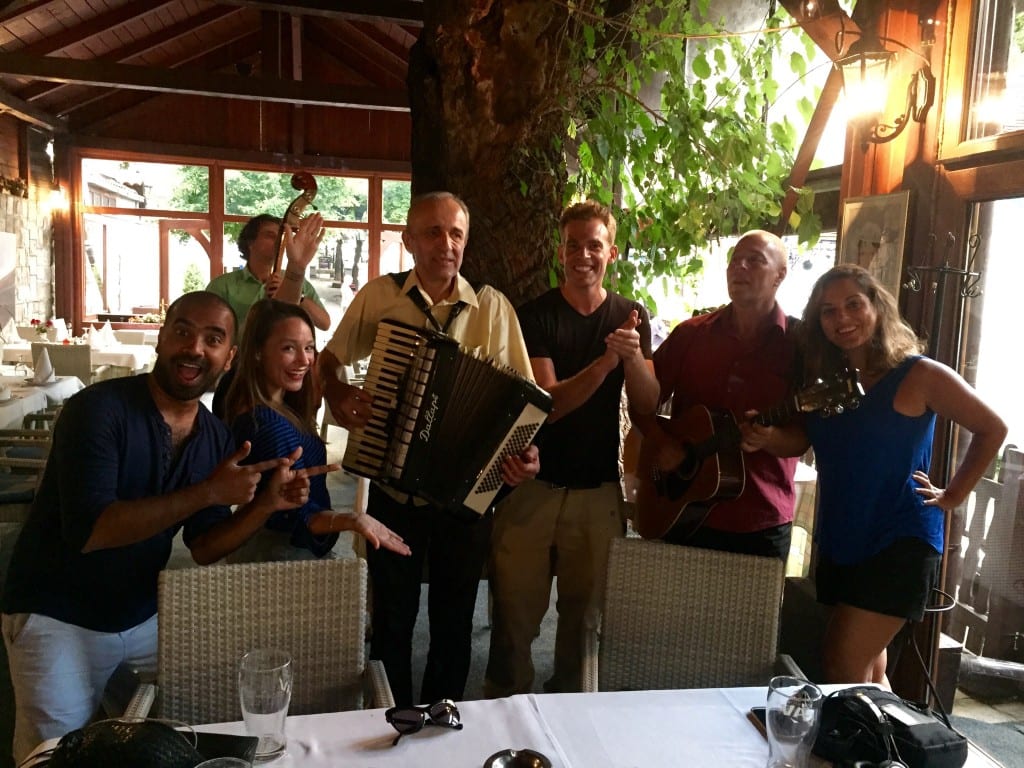
Solo Female Travel in Serbia
Serbia doesn’t get as much publicity as the other Balkan countries — it doesn’t have the striking coast or memorable lakes, and while it has a vibrant city in Belgrade, it just doesn’t get quite the publicity of Dubrovnik, Kotor, or even Ljubljana.
Serbia is also the Balkan country that I’ve explored the least — I’ve only been to Belgrade. But Serbia is home to plenty of interesting cities, monasteries, and national parks. Also here is EXIT Festival, one of the best music festivals in Europe, which can be a lot of fun if you’re into hitting up music festivals solo.
There is one sensitive subject in Serbia that you should be careful about mentioning: Kosovo. Serbia doesn’t recognize Kosovo as a country — they consider Kosovo part of Serbia. While most of the narratives are framed as Serbia attacking the Kosovars, particularly if you’re American, keep in mind that some Serbians were killed by Kosovars. This conflict has been a long source of trauma for both countries.
I made the mistake of talking about Kosovo with a Serbian while traveling solo, and when I realized what a mistake I had made, it felt like a target had been put on me. That is something you want to avoid when traveling on your own.
Serbia makes a strategic entry point into the Balkans, as it’s nestled up against Romania, Bulgaria, and Hungry. Belgrade is a six-hour bus ride from Budapest.
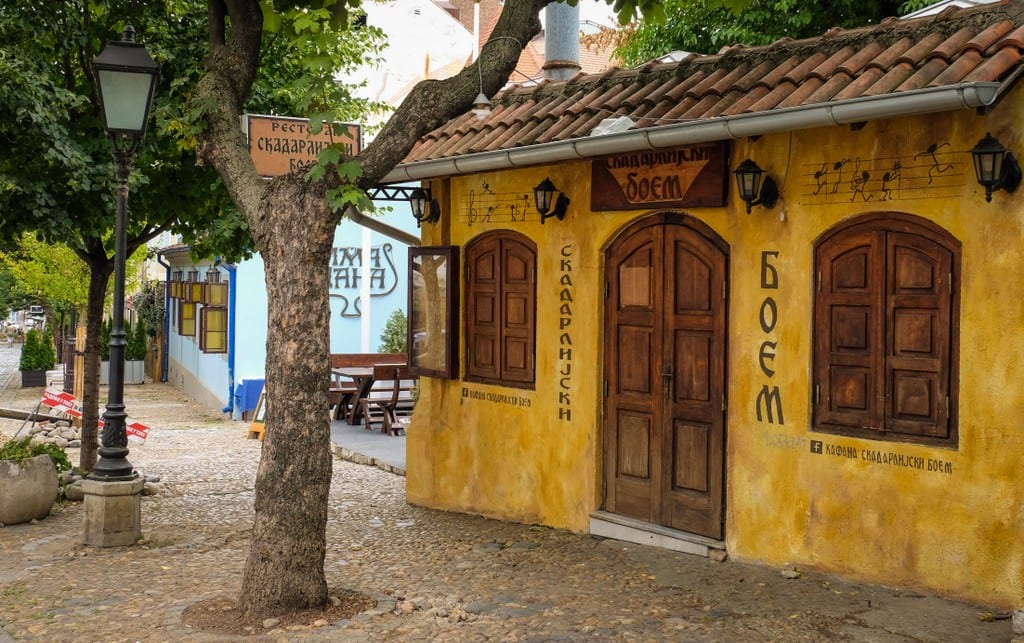
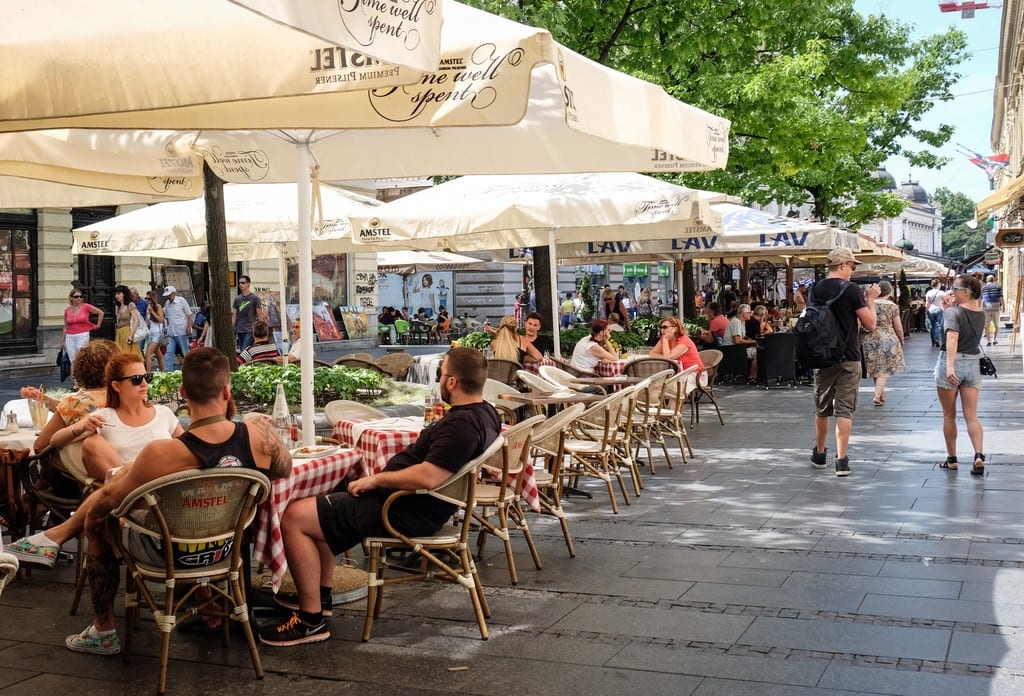
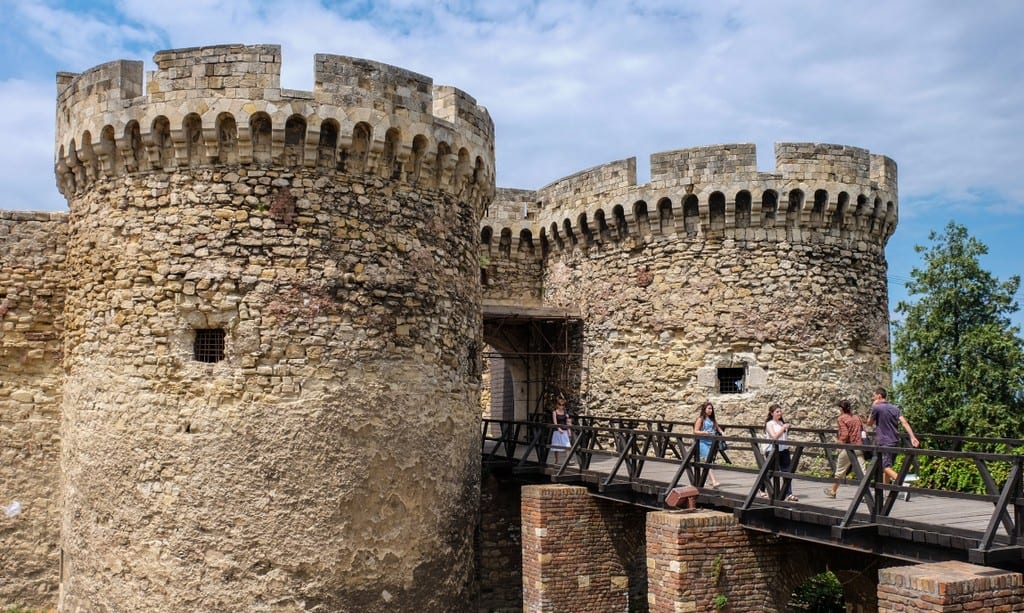
Best Things to Do in Serbia
Have a NIGHT OUT on the river barges in Belgrade. Belgrade is well-known for being the best nightlife destination in the Balkans — and one of the best in Europe. People party on the barges anchored at the confluence of the Danube and Sava Rivers.
Go to EXIT Festival. This music festival in Novi Sad is one of the biggest music festivals in Europe, drawing big names each year. If you want to visit one of the biggest trend-setting festivals, EXIT is one of the best you could attend.
Explore Tara National Park. Serbia might not be as famous as its neighbors when it comes to natural beauty, but that changes when you see Tara National Park. This park, nestled up against the Bosnian border, is home to stunning mountains, rivers, and ravines.
Visit Studenica Monastery. Serbia’s largest monastery, located in the Raška district of central Serbia, is a UNESCO World Heritage Site with two churches built from white marble and a collection of Byzantine paintings.
Spend an afternoon at Kalemegdan Fortress. Located in the heart of Belgrade, this is one of the most famous sites in the city — but for locals, it’s more popular to hang out there with a beer when the weather is nice.
Explore Novi Sad. Serbia’s second city is arguably the prettiest place in Serbia, with pastel-painted architecture and a beautiful main square.
Ski in Kopaonik National Park. You may not have considered skiing in Serbia — but this national park is home to some terrific slopes at a fraction of the cost of Western European resorts.
Hang out with Bald Jesus. The church of St. Peter and Paul in the small town of Rsovci is notable for being inside a cave. But even more unusual is the fresco of a bald Jesus on the wall, a tiny tuft of hair springing up from his head. Strange? Yes. Good luck finding a bald Jesus anywhere else!
Read more about Serbia:
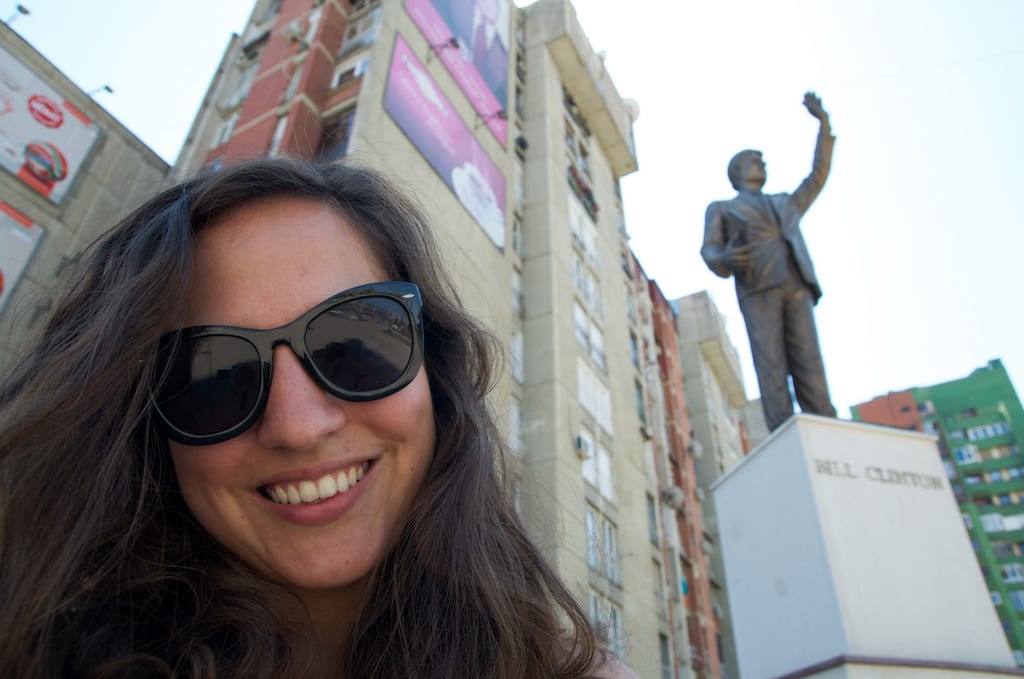
Solo Female Travel in Kosovo
Kosovo blew me away from the moment I arrived. As I rode the bus from Skopje, I gaped at the jaw-dropping mountain scenery. The man who collected my American passport burst into a grin. “I love this country,” he said, gesturing to the passport, “I love this flag.” This was just the beginning of the warmest welcome I have received in any country, ever.
Mention Kosovo to someone of my generation and they may recall vague memories of mid-90s newscasts: war, violence, ethnic cleansing at the hands of the Serbs. US military intervention that saved Kosovo without a single American life lost.
Is Kosovo safe and worth visiting today? Yes. Those terrible days were more than two decades ago, and Kosovo is now a very safe place to travel.
Perhaps the phrase “ethnic Albanians” will jog your memory because that’s who Kosovars are: ethnic Albanians who speak Albanian and are largely secular Muslims. Go to Kosovo and you’ll be surprised by how many blood-red Albanian flags you’ll see!
The most important thing to know about visiting Kosovo is that Serbia does not recognize Kosovo as its own country — nor does the United Nations, as countries like Spain and China refuse to recognize Kosovo (and with strong separatist regions like Catalonia and Taiwan, you can understand why). Serbia considers Kosovo to be part of Serbia.
For this reason, you must exit Kosovo depending on the way you went in. If you enter Kosovo from North Macedonia, cross into Serbia, and leave Serbia for, say, Bosnia, the Serbs will say that you entered Serbia illegally. If you leave Serbia without a Serbia exit stamp and go back in the future, they’ll say you exited Serbia illegally. Go back the way you came.
It’s also important to know that there are still unexploded landmines in remote parts of Kosovo. If you’re walking in the countryside, never walk off-trail, and only go hiking with a guide.
I found Kosovo to be cheap and quirky with some VERY memorable architecture. But I will always remember how warmly everyone welcomed me, how total strangers asked for my phone number so they could check up on me later. As a solo traveler, that kindness was invaluable. I’ll remember it for the rest of my life.
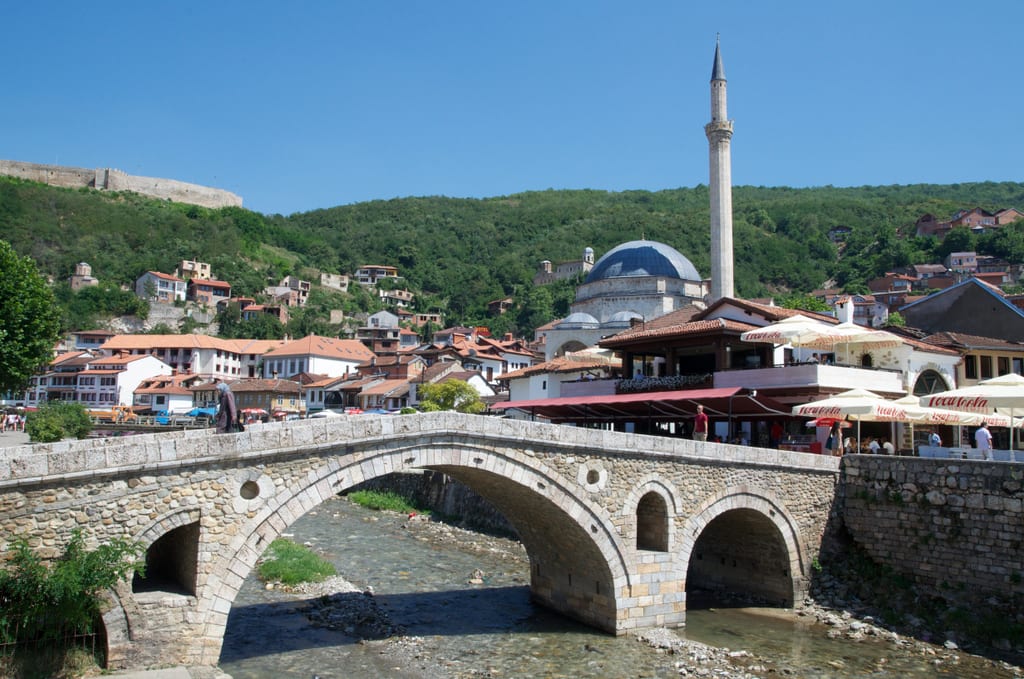
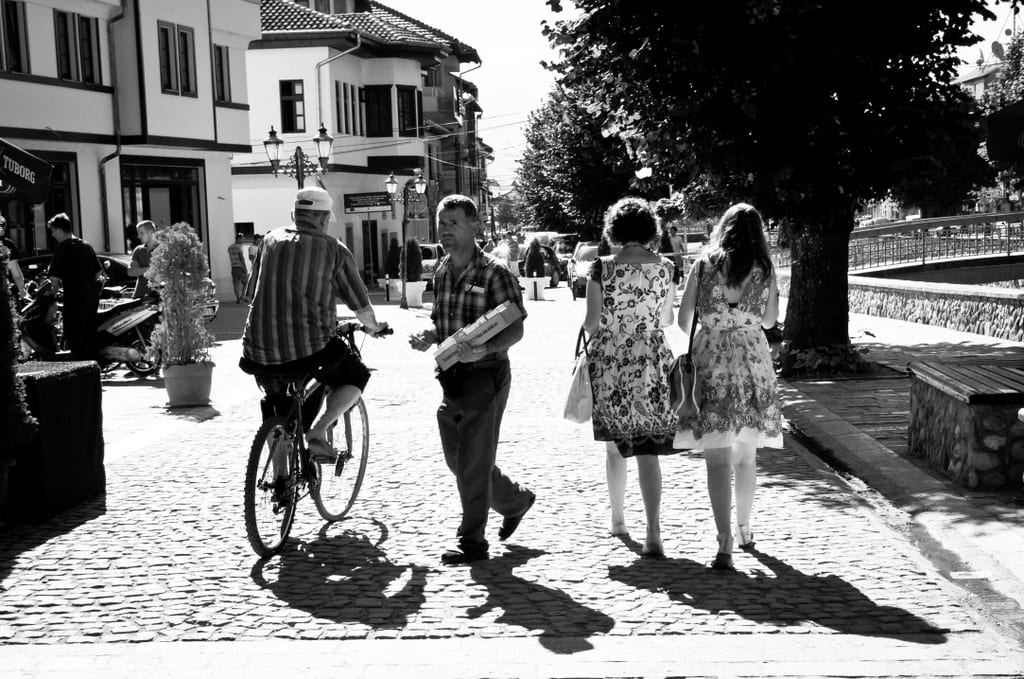

Best Things to Do in Kosovo
Take a selfie with the Bill Clinton statue. It’s such an odd place! And hilariously, it’s next door to a dress shop named Hillary.
Visit the monasteries in Peja. While Kosovo is primarily Muslim, there is a sizable Serbian Orthodox minority. This is reflected in the beautiful churches around the country, including some near Peja.
Marvel at the look of Prishtina’s library. The Balkans are a region of offbeat architecture, but this eggs-in-metal-cages aesthetic has to be the strangest of all.
Talk to everyone you meet — especially if you’re American. Most Kosovars I met were delighted to meet a tourist, and perhaps a bit perplexed — why would someone from America want to come here? Also, know that if you’re past your mid-twenties and unmarried, people will want to know why.
Get into Kosovo’s cafe culture. Two places where I enjoyed sitting down with a cup of coffee were along the river in Prizren and on Raki Street in Prishtina.
Explore Rugova Canyon. This canyon, near Peja, is one of the deepest canyons in southeast Europe. This region is popular for outdoor activities like hiking, caving, and biking.
Climb the fortress in Prizren. This will give you panoramic views of Kosovo’s most beautiful city. Be smarter than me — don’t wait until it’s the hottest part of the day.
Visit the bear sanctuary in Novo Selo. Bears used to be used for entertainment at destinations throughout Kosovo — this is now an illegal practice. This sanctuary allows the bears to live out their lives in peace and comfort.
Read more about Kosovo:
Kosovo: A Warm Welcome from a Newborn Country

Solo Female Travel in North Macedonia
It’s a bit of an adjustment writing “North Macedonia” instead of “Macedonia” — the country officially changed its name in 2019. Previously it was known as the Former Yugoslav Republic of Macedonia, or FYROM. While most people shortened it to Macedonia, this angered many Greeks who claimed that their own Macedonia region was the only Macedonia. Enter the compromise.
North Macedonia is one of the biggest mysteries among the Balkan countries. It’s not particularly famous for anything in particular, other than Lake Ohrid. It’s one of the cheapest and least developed countries in the Balkans, and while it has Lake Ohrid, it doesn’t have any of that legendary Balkan coastline. The Peace Corps has more volunteers here than any other Balkan country.
I fell hard for North Macedonia when I visited — and as I type this, I’m struck by how much I’m yearning to return. It’s a stunningly beautiful country, but in a way you don’t expect. Sometimes the underdogs can make the strongest impressions on us.
I was very comfortable traveling solo in North Macedonia and met several women doing the same. While North Macedonia has a few train lines, locals told me that it was smarter to travel by bus. Buses in North Macedonia are faster, higher quality, and run more often. I also found it convenient to use Skopje as a base for further exploration — you can easily get buses to Kosovo, Albania, Bulgaria, Serbia, and Greece.
One last thing — North Macedonia is the only Balkan country to primarily use Cyrillic script. There is enough Latin script signage to figure things out, but learning a bit of Cyrillic can help you sound words out. (Side note: the scariest thing I saw in North Macedonia was a toilet surrounded by lots of urgent-looking signage in Cyrillic.)
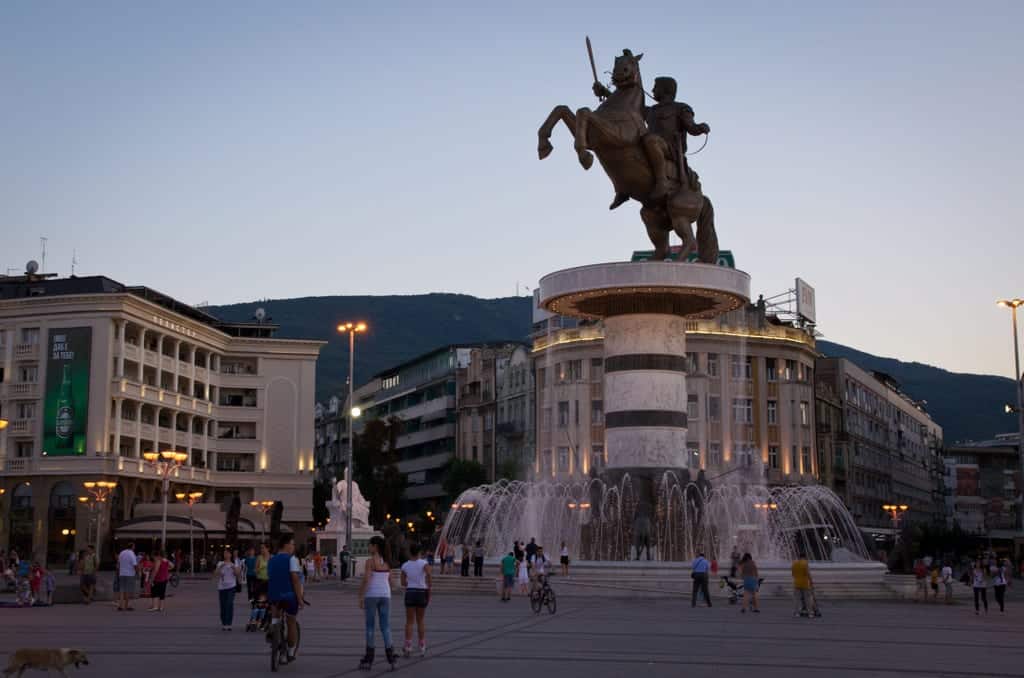


Best Things to Do in North Macedonia
Gawk and laugh at the outlandish sculptures around Skopje. These sculptures were recently built as part of the “Skopje 2014” project. I called the city “Skop Vegas” because so many of the sculptures evoke the “modern Roman” look of Caesar’s Palace.
Spend a few days chilling out in Ohrid. Macedonia’s summer hotspot is best known for the postcard image of Sveti Jovan monastery on the edge of the lake, but this is a beautiful small town worth exploring.
Hang out on Širok Sokak and people-watch in Bitola. This cafe-lined street is the place to see and be seen. Get an outdoor table with a coffee in the afternoon, and check out all the dressed up locals as they walk down the street in the evening.
Take a boat ride through Matka Canyon. Just south of Skopje, this canyon is a great place to get into the outdoors and enjoy an afternoon of hiking and swimming.
Take the cable car to the top of Vodno. This journey gives you unmatched views over the city of Skopje.
Get lost in the bazaars. Skopje’s bazaar is large, extensive, and a great place to buy art and handmade goods. Bitola’s modern, low-key bazaar is worth a visit, too.
Take a boat ride across Lake Ohrid to Sveti Naum. Down on the edge of the Albanian border, Sveti Naum is home to an orange-brick monastery complex, several seaside restaurants, and bizarrely, shrieking peacocks. You’ll pass the president’s summer home en route.
Sample all the North Macedonian wines. You would be shocked at just how good these wines are, especially the reds. You’d also be shocked at their low price tag. There are several varietals that are only grown in North Macedonia; I recommend you try these while you’re there.
Read more about North Macedonia:
North Macedonia’s Magnificence Will Surprise You
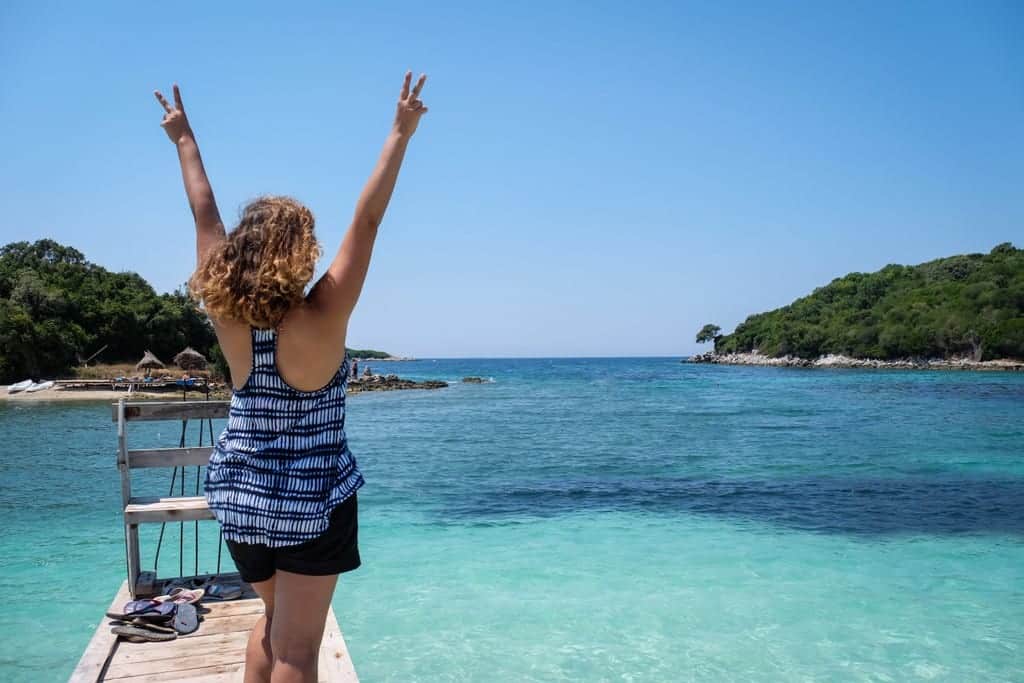
Solo Female Travel in Albania
You think you know the Balkans, and then you get to Albania. Albania is the most challenging country to travel in all of the Balkans. It’s the poorest country, the least developed country, one of the cheapest countries, and has the biggest language barrier (and since Albanian is related to zero other living languages, you can’t exactly pick it up).
And it is weird. When dictator Enver Hoxha ruled Albania, the country was cut off from the world for years in a self-imposed exile, almost frozen in time. (Today, my Albanian friend tells me she loves visiting Cuba because it feels like her childhood in Albania.)
To this day, there are military bunkers all over the country — many of them looking like an alien’s spaceship — and some are even turned into businesses like cafes and guesthouses. You’ll even find one in Blloku, the chic, cafe-filled neighborhood that used to be off-limits to everyone but Hoxha and his higher-ups.
Albania is challenging for women traveling alone, which is why I recommend it for experienced solo female travelers. The most difficult thing about traveling in Albania is figuring out the bus system. Some cities don’t have central bus stations, Tirana and Saranda among them, and travel agencies will only sell tickets for certain routes.
Combine that with the language barrier and the simple act of buying a bus ticket was often a frustrating experience. Once I arrived in a town where my connecting bus was nowhere to be found and I basically paid a guy with a van to take me to Berat. (I was VERY relieved to take a tourist shuttle from Tirana to Budva in Montenegro. See more on that in the “How to Get Around the Balkans” section below.)
One other thing to know is that most Albanians are Muslim, though virtually all of them are quite secular (case in point: they drink). I only saw around three women wearing a hijab the whole time I was in Albania.
While it’s been a bit of a travel industry secret that Albania’s beaches are some of the most beautiful in Europe, the country is lesser known for its mountains and hiking. But word is spreading. I think that a decade down the road, Albanian will be a popular outdoor destination in southeast Europe.
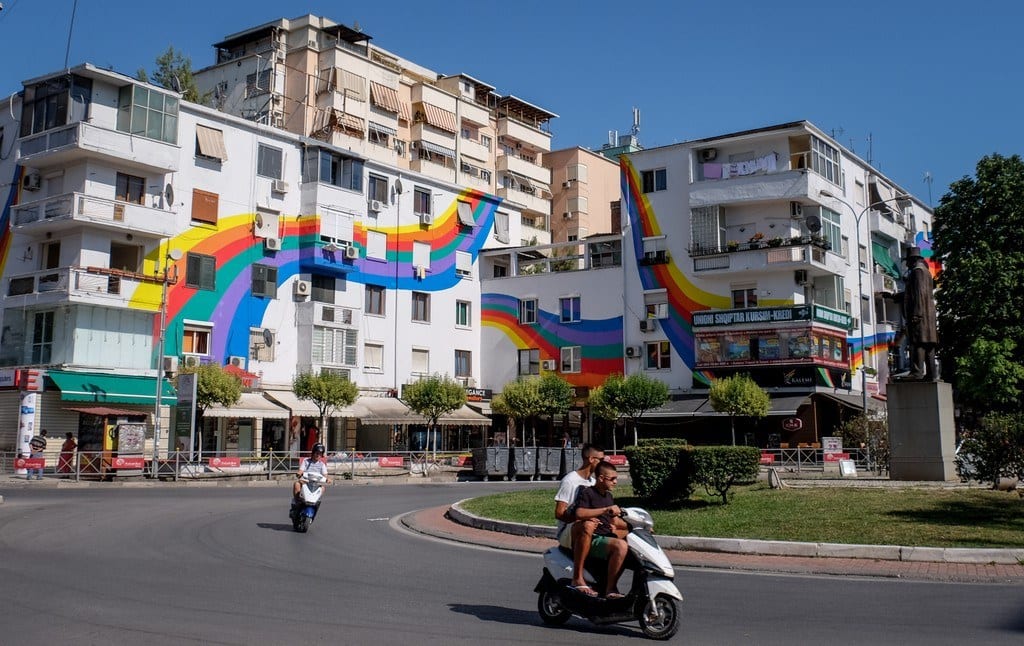
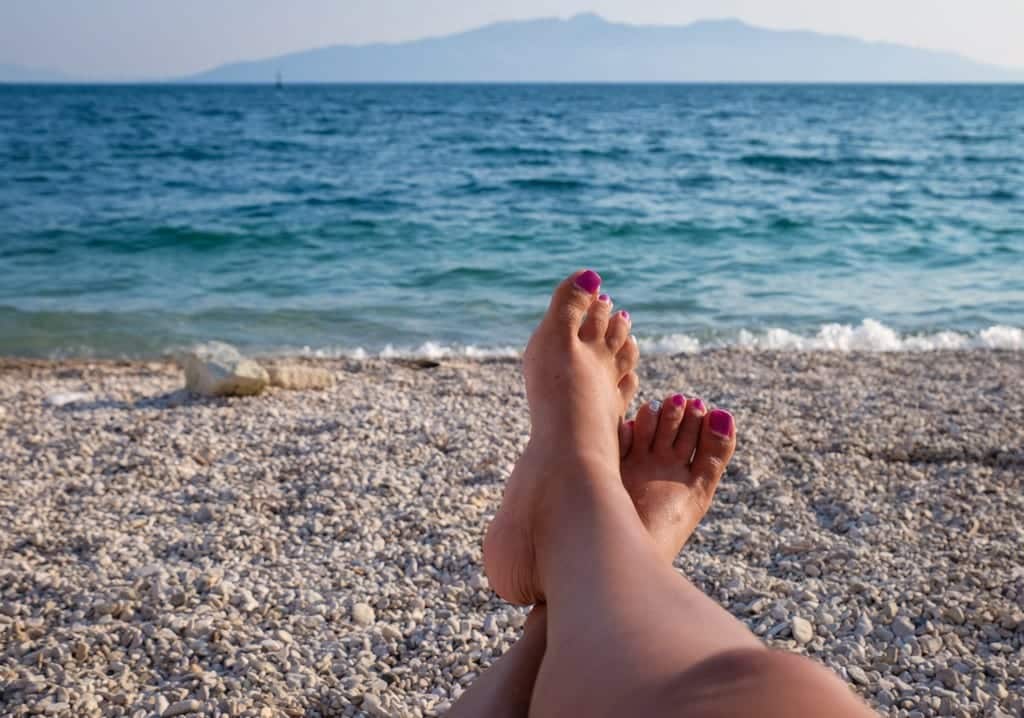
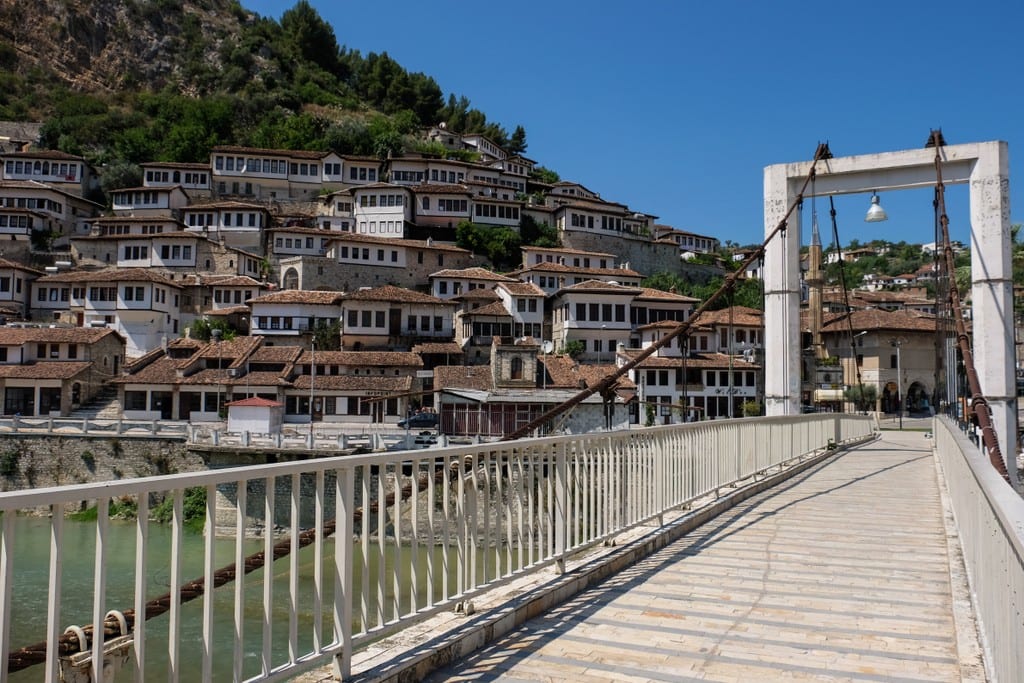
Best Things to Do in Albania
Rent a car and drive up the coast around Himare, spotting your own perfect beach. Albania’s best beaches are inaccessible by public transit, so you’ll have to do the exploring on your own! The best ones require a bit of a walk.
Have sparkling wine overlooking the city for cheap. Enjoy drinks on top of the tallest building in Tirana for the equivalent of a few dollars per glass.
Watch the streets of Berat come to life just before sunset. All day, there won’t be more than three people on the street at a time. Then once evening hits, watch the street swell with thousands of people, all ages, knowing it’s the place to see and be seen.
Take a swim in the Blue Eye. Located between Saranda and Gjirokaster, this swimming hole is home to ice-cold, clear, dark blue water, surrounded by forest.
Climb to the top of Tirana’s pyramid. This sci-fi like structure has since been covered in graffiti — go ahead and join the kids climbing up and sliding down!
Hike in the mountains near Shkoder. If Montenegro is the next Croatia, Albania is the next Montenegro — and the country is quickly becoming better known for its full-day hikes in the northern part of the country.
Explore the ruins at Butrint. These are some of the best preserved Roman ruins in the Balkans.
Spend a beach resort day at Ksamil. Then marvel at the fact that few people outside Albania have ever heard of this place.
Read more about Albania:
What’s it Like to Travel in Albania?
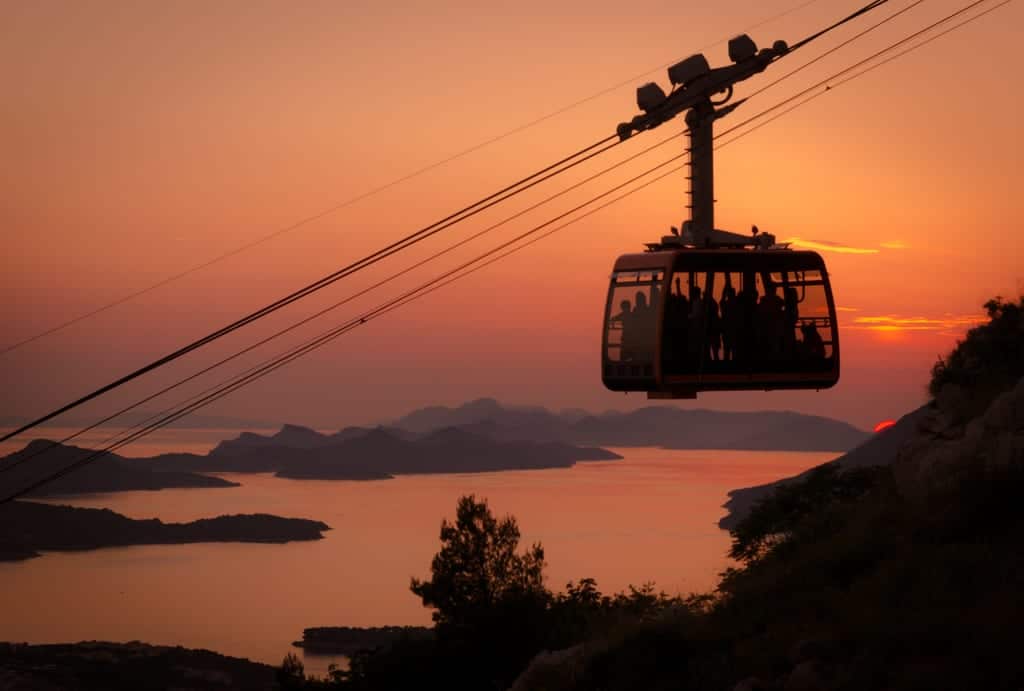
Balkans Travel and Safety Tips
Know their history — and current tensions. I know that the history of the former Yugoslavia isn’t the most riveting subject, but reading up will give you so much context for your trip.
You may want to get SIM cards for your trips — but do your research. If you have a SIM card from home that works in several countries, keep in mind that it may not cover all of the Balkans. If not, wifi in the Balkans is far faster and more reliable than it used to be, and you can survive without data if you need to.
The countries of the Balkans use different currencies. The euro is used in Slovenia, Kosovo, and Montenegro — every other country has their own currency (Croatian kuna, Bosnian mark, Serbian dinar, North Macedonian denar, Albanian lek).
The cheapest way to exchange money in the Balkans is to get money out direct at the ATM. If you have any extra left over, there are plenty of exchange shops all over the region. You can also exchange with a traveler heading in the opposite direction.
It might help to learn a bit of Cyrillic. North Macedonia primarily uses Cyrillic script; you may see a bit of Cyrillic in Serbia, Kosovo, and Bosnia as well. Once you learn Cyrillic, you can easily sound words out. And don’t worry — it’s easy to find translations in Latin script!
Fake a phone call when getting in a taxi. When you’re getting in a taxi alone, open your phone, pretend to make a call, and make a big deal over walking to the license plate and reading it out loud. While most drivers are perfectly fine, this lets them know that someone is looking out for you.
Always verify that a meter is working before you get into a taxi. Some drivers will claim the meter is broken, and this is a lie to get you to agree to a higher fixed rate. If it’s “not working,” get another cab.
Clothes shopping is fun and super-cheap in the Balkans — but know that women tend to be very thin here. You’ll struggle to find clothing larger than a size 8.
See a travel doctor before your trip and be prepared on what to do if you get sick. While some Balkan countries have excellent healthcare systems, not all of them are equal. If you’re planning extensive travels, it’s not a bad idea to see a travel doctor periodically and ask her if there’s anything you should be doing.
Is the water safe to drink in the Balkans? For the most part, yes, it’s safe, but there are some exceptions. You can go ahead and drink the water in Slovenia, Croatia, Bosnia, Serbia, and Montenegro.
There are a few water safety exceptions: in Kosovo and Albania, the water is technically safe to drink, but most locals never drink it because it tastes unusual. In Albania, this is due to chlorination. In North Macedonia, the water is safe to drink in urban areas like Skopje, but in some rural areas, it’s not. It’s good to ask someone in the destination you’re visiting.
While most travelers rely on bottled water, it creates a major waste problem. For this reason, I recommend you bring a LifeStraw, a bottle that purifies water as you drink it through its straw. Alternatively, you can bring a reusable bottle and invest in a SteriPen water purifier (much better and faster than tablets).
Learn a few words of the local language. It’s not necessary in the Balkans, where most people speak a lot of English, but just saying thank you can bring a smile to a local’s face. It’s hvala in most countries and faleminderit in Albania and Kosovo.
Keep your valuables locked up in your accommodation and only take with you what you need that day. I do this with my Pacsafe Travelsafe and I consider it the most important thing I pack. Keep an extra debit card and at least $100 hidden in obscure parts of your luggage.
Get an extra debit card. You should have two debit cards to two different bank accounts. If you only have one, I recommend you get a debit card from Transferwise. Keep a few hundred dollars in your account, hide the card deep in your luggage, and use it if your primary debit card is stolen.
Never leave your bags anywhere unattended. Even if you’re used to asking someone at the next table to watch your things while you use the bathroom in a coffeeshop at home, don’t do that in the Balkans. Take your belongings with you. If you’re keeping your bag under the table or otherwise out of sight, keep it between your feet or hook the strap around one of the chair legs.
Don’t flash your valuables and limit your expensive jewelry. Be especially cautious at tourist areas and on public transportation.
If you carry a purse, hold it close to you. I recommend a crossbody purse, made out of a tough material like leather or fake leather, that zips shut. I recommend many purses in this post. Never let it hang behind you — always keep it in a place where you can see it, and keep your hand on it if you’re in a crowd.
If you carry a wallet without a purse, don’t keep it in your back pocket. This is obvious to thieves. They will grab it and run.
Be careful about your drinking. Drink less than you ordinarily would at home — two drinks is a good limit. Only take drinks from bartenders, never take a drink from a stranger, and always keep it with you and keep an eye on it. Be especially cautious in party spots like Hvar and Belgrade, but drink spiking can happen anywhere.
Especially be cautious when it comes to rakija, a popular liquor in the Balkans. It is extremely strong — especially if it’s homemade. Be cautious with rakija and definitely don’t go shot for shot with a local!
Do not take drugs, even if you’re a party drug enthusiast. Drugs in the Balkans can be cut with poisonous substances that can often lead to your death, and if you’re caught by the police, you’ll be in life-changing trouble.
Spend extra money on staying safe. If it costs you money to take a taxi rather than walk, or to stay in a guesthouse in a well-lit, central neighborhood, do it. It’s worth the peace of mind. Don’t pinch pennies on your safety.
Bring a digital Balkans guidebook. I always bring PDFs of Lonely Planet guidebooks — they have critical information, like details on transportation and the locations of medical centers, and a digital version adds no weight to your bag. You can buy the book or individual chapters, and I keep my PDFs in the Books app on my iPhone.
I recommend Lonely Planet Western Balkans if you’re just visiting the Balkans or Lonely Planet Europe if you’re visiting other parts of Europe as well.
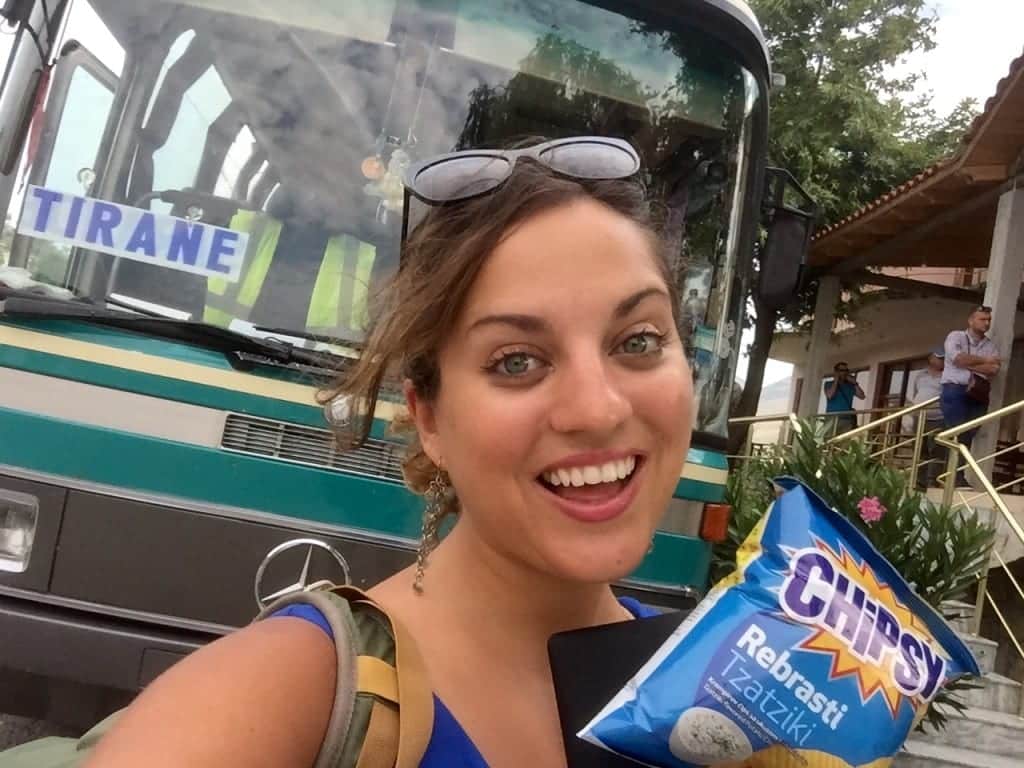
How to Get Around the Balkans Solo
Traveling in the Balkans is different from traveling in Western Europe. The train coverage isn’t as good (most notably, there is no train to Dubrovnik), the driving can be hairy in some countries, and you often have to cross borders in inconvenient places.
The Balkans are less developed than much of Western Europe, and for this reason, transportation often takes much longer than you would expect. This is a big reason why I encourage you to take your time and not plan a packed schedule.
Getting to the Balkans
It can often be pricey getting a flight into the Balkans from North America, but there are hacks to make it cheaper. Croatia has exploded as a destination in the past 15 years and it’s probably easiest to find an affordable flight here. I recommend starting by using Skyscanner to price out the cheapest flights.
Sometimes it can be significantly cheaper to book a flight from North America to a European hub, like London or Paris or Milan, then book a budget flight on an airline like RyanAir or EasyJet to a destination in the Balkans.
If you do this, keep in mind that traveling from airport to airport is often hellish (but not so bad if you use the hub city as a few days’ layover). I recommend carrying on your luggage because if it’s lost on your first leg, it won’t make it to your second.
In the past I’ve taken very cheap flights from Manchester, England, to Pula, Croatia; from London to Zagreb; and from Istanbul to Skopje.
Other travelers arrive in the Balkans overland. Many arrive by boat from Italy (to destinations in Slovenia, Croatia, and Albania) or Greece (the ferry from Corfu to Saranda, Albania). Some of the bigger train hubs are Ljubljana, Zagreb, and Belgrade. And buses can take you all over the Balkans.
Getting Around the Balkans by Train
There aren’t a lot of train lines in the Balkans. I recommend taking a look at the Eurail map (warning: large file) to see the train lines that DO exist. But the map doesn’t tell the whole story.
Trains in Slovenia: Many destinations are decently connected by train, and from Ljubljana you can travel internationally to Zagreb, Vienna, Budapest, and beyond by train (though frustratingly, not Trieste, Italy).
Trains in Croatia: Trains from Zagreb run to Pula in Istria, to Split in Dalmatia, and to Osijek in Slavonia. Once again — there is no train to Dubrovnik, nor are there trains to popular destinations like the Plitvice Lakes. Trains to some popular destinations, like Zadar, are slow and limited, and better done by bus.
Trains in Bosnia: There are some domestic trains in Bosnia but buses are nicer, faster, and run more often.
Trains in Serbia: There are some domestic trains in Serbia but buses are nicer, faster, and run more often. However, the 11-hour train from Belgrade to Bar, Montenegro, is absolutely gorgeous. You can do it during the day or overnight.
Trains in Montenegro: There are a few domestic trains in Montenegro but none to the popular coastline towns like Kotor, Budva, and Sveti Stefan. The 11-hour train from Bar to Belgrade, Serbia, is spellbinding. You can do it during the day or overnight.
Trains in Kosovo: Kosovo’s train lines are slow and it’s faster to travel by bus, especially the route from Prishtina to Prizren.
Trains in North Macedonia: There are a few domestic train lines in North Macedonia, but buses are nicer, faster, and run more often.
Trains in Albania: Albania only has trains between Tirana and Durres, but it’s faster and more efficient to travel this route by bus.
Getting Around the Balkans by Bus
If you’re taking public transportation in the Balkans, you’ll likely be traveling primarily by bus. Taking buses in the Balkans is fairly straightforward: you go to the station and buy a ticket, or you buy a ticket from a tour agency.
When you cross borders in the Balkans on a bus, usually there will be someone on board who collects all the passports, gets them stamped, and brings them back to you afterward. You stay on the bus the whole time. Sometimes, like on the Croatian coast where you annoyingly have to cross into Bosnia and back into Croatia a few minutes later, an agent comes on the bus and just looks at your passports. Occasionally you’ll get off the bus.
Overall, taking buses in the Balkans is efficient and fairly straightforward.
There is one exception: Albania. Tirana is one of few world capitals without a central bus station, and different ticket agencies sell tickets for different bus lines. You may be picked up or dropped off on the side of the road. I had to go door-to-door in Saranda before finding a place that could sell me a ticket to Berat, and the language barrier made things very difficult.
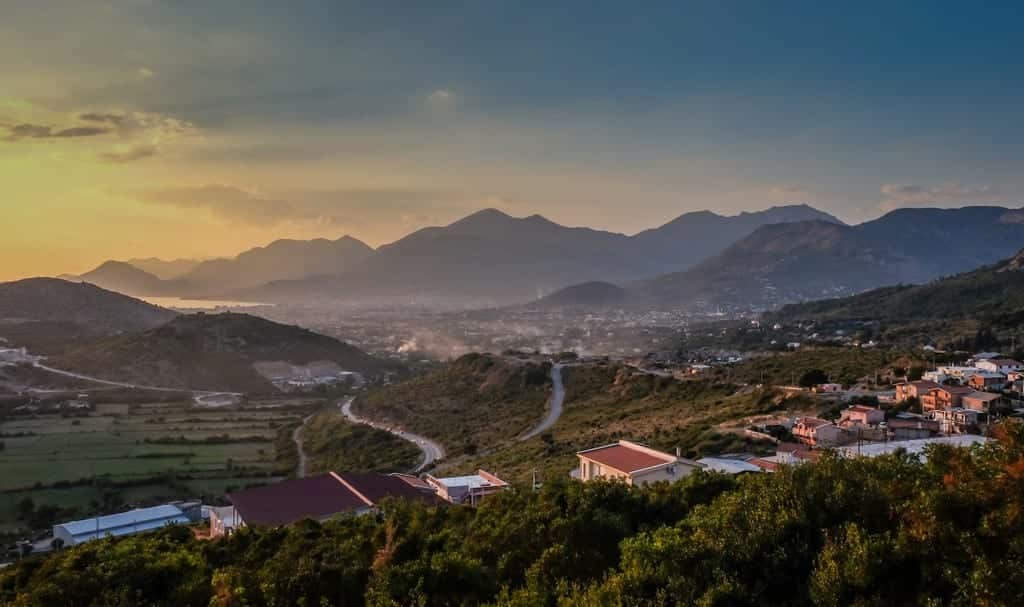
Getting Around the Balkans by Tourist Shuttle
On some routes in the Balkans there are tourist shuttles — basically a minibus or regular bus that take you directly from one tourist hub to another. These are more expensive, but they save you a ton of time and are far more comfortable, with good seats and air conditioning.
There are two major routes that I recommend doing by tourist shuttle: the first is from Bosnia to the Montenegro coast, and the second is from Albania to the Montenegro coast. If you do either of these by public transportation, they will take an insanely long time and require several changes.
Montenegro Hostel runs tourist shuttles along these routes and I took their shuttle from Tirana to Budva. It was a great experience and I highly recommend them. They let us stop for photos when we passed Sveti Stefan at sunset!
Getting Around the Balkans by Boat
If you’re traveling the Adriatic coastline, you’ll probably hop on a boat at some point. Jadrolinija run an extensive network of domestic ferries in Croatia in addition to some international routes to Ancona and Bari in Italy, including one ferry from Bar, Montenegro, to Bari.
You can check the full schedule of ferries here.
If you’re traveling to Albania, you may find it easier or cheaper to fly to Corfu, Greece, and take the ferry to Saranda, Albania. This is what I did. Several ferries run this route and it can take 30-90 minutes. Buy your ticket ahead of time at the ticket office, not the port!
Likewise, you may enjoy flying into Venice, taking a train to Trieste in the Friuli-Venezia Giulia region of Italy, then taking the 30-minute ferry to Piran, Slovenia.
Getting Around the Balkans by Air
Sometimes the overland travel time can be so long that it’s easier to fly from city to city. Zagreb to Dubrovnik is one route that can take very long on public transit (13+ hours) but less than an hour by plane.
I prefer traveling overland in the Balkans when possible. But if you’re looking for cheap flights within the Balkans, I recommend using Skyscanner.
Keep in mind that many flight routes to the Balkans are seasonal — especially to popular summer destinations like Dubrovnik.
Renting a Car in the Balkans
Renting a car can be a great way to explore the Balkans, get off the beaten path, and explore small towns in addition to large cities, but not all Balkan countries are created equal!
I’ve road tripped in Croatia and Slovenia and both of those countries are ideal for driving — roads are in great condition, the driving is reasonable (though I found Slovenians to be a bit aggressive behind the wheel), lots of interesting small towns to explore. I highly recommend exploring these two countries by car.
Beyond that, driving can be a bit more challenging in the remainder of the Balkans — slower driving routes, less developed roads, and some countries have VERY crazy driving (I’m still reeling from Montenegro).
In Albania the roads are in the worst condition. But if you want to see the most beautiful beaches in the Balkans, renting a car in Albania is pretty much the only way to do so.
Before renting a car in the Balkans, I recommend getting an International Driving Permit in your home country. It’s essentially a translation of your license. Most places don’t require it, but it’s a good thing to have.
If you’re looking for a cheap car rental in the Balkans, I recommend using RentalCars.com.
One major tip — before you book, double-check that you’ll be allowed to drive to different countries, if you plan on crossing borders. Your rental company may not allow this.
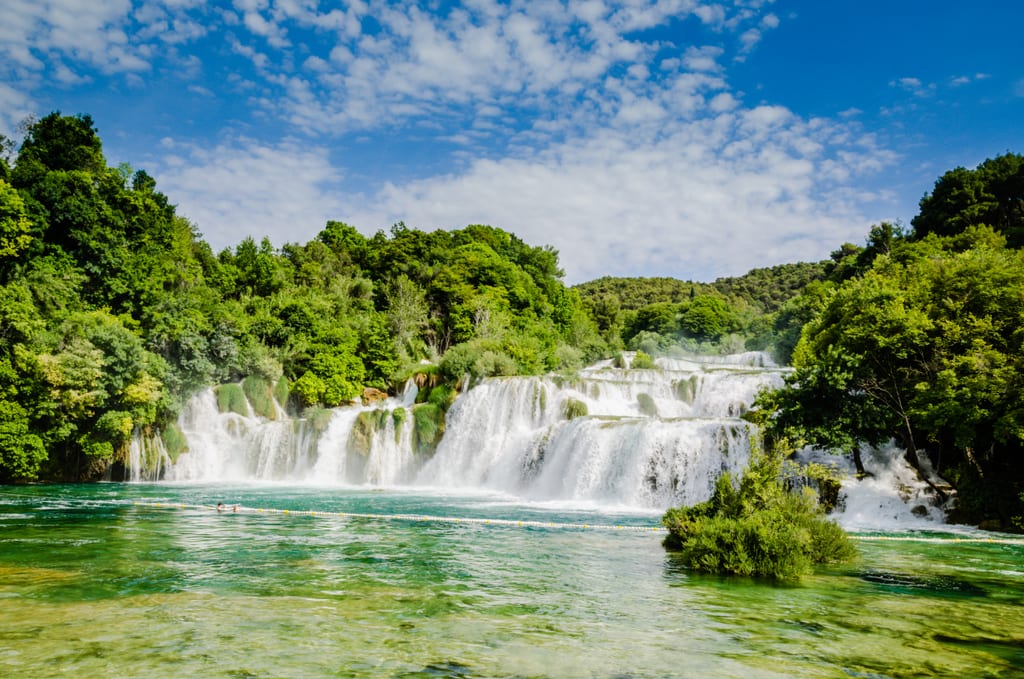
Best Time to Visit the Balkans
I personally believe that the best time to visit the Balkans is in the shoulder season: late April, May, early June, mid-to-late September, and October. These months of the year give you mostly beautiful weather, pleasant temperatures, and it’s cheaper and not as crowded as the summer months.
Most people travel to the Balkans in the summer (mid-to-late June, July, August, and early September), and I have done a lot of summer Balkans travel, but I encourage you to avoid this time if you’re not focusing on islands and beaches. This is a beautiful time of year to visit the Balkans, but it can get VERY hot.
The summer months the most crowded and expensive time to visit the Balkans. August is the month of peak tourism and pricing, though July is also fairly intense. The absolute worst crowds are at Dubrovnik on summer days when cruise ships are in port. (I’ve written about how to avoid the worst Dubrovnik summer crowds here.) Popular day trip spots like Mostar and Kotor swell in population during the day, but are much more pleasant at night.
If you’re going to the Balkans for beach and island time, I recommend traveling in September — it’s outside peak season, and the water is much warmer in September than in June.
There are a few exceptions. Many Albanian and Montenegrin beach resort towns are essentially closed from October through May, so if those beaches are a priority, go during the summer. Some Balkan mountain treks are best done in the summer months because it can get cold at night. And most Balkan music festivals take place during the summer.
Visiting the Balkans in the winter can be a nice option if you don’t mind colder weather. There are some ski resorts in Bosnia and Serbia where you’ll pay a fraction of what you’d pay to ski in France or Austria. For photographers, getting snowy photos of places like the Plitvice Lakes can be rewarding.
Zagreb is well-known for its Christmas markets, making December a lovely time to visit that part of Croatia.
Eating Alone in the Balkans
It’s completely normal to eat while alone in the Balkans. Nobody will think it’s weird that you’re eating alone.
In a region with a big cafe scene, many of the cafes in the Balkans serve food as well as drinks. Eating alone at a cafe can be a bit less intimidating if you’ve never done it before — but again, I encourage you to eat in restaurants. There’s nothing to be afraid of!
The only country where things were a bit unusual was in Kosovo — sometimes, after finishing a meal, waiters would ask if they could have my phone number. This was before we had even had a conversation. It wasn’t because they were hitting on me — it’s because they genuinely wanted to check up on me and make sure I was doing okay later. That’s Kosovo for you!
The Balkans are best known for their grilled meats. In fact, if you’re traveling the Balkans for a longer amount of time, you’ll probably be sick of grilled meats at some point. It can be tough being a vegetarian in the Balkans and very tough being a vegan, but the HappyCow app is your best bet for finding plant-based eats.
If you’re sick of Balkan food, you can find pizza almost everywhere.
What to Eat in the Balkans
There are so many delicious things to eat in the Balkans! Here are a few of my favorites:
Burek — A large flaky pastry that can be stuffed with anything from cheese to spinach to meat. These are a snack for any time of day and you can find these all over the Balkan countries.
Pag cheese — A hard sheep’s cheese from the island of Pag in Croatia, you can find this all over the Croatian coast. I like snacking on thin slices with a glass of local wine.
Ćevapčići — I ate so many of these in Bosnia. Ćevapčići or ćevapi are small oblong sausages, usually made from beef but sometimes mixed with pork or lamb. In Bosnia are served with pita and raw onions, and ajvar (spicy red pepper spread) or tomatoes, but different regions serve them differently. This is the only context in which I will eat raw onions.
Šopska salads — With so much meat on the menu in the Balkans, this is a reliable meatless option. Šopska salads, or shopska salads, are made from chopped tomatoes, cucumbers, peppers, onions, and topped with a shaved white cheese similar to feta. I ate these daily in North Macedonia.
Pršut — The version of prosciutto that you see in Croatia in Slovenia is thicker and saltier than Italy’s varieties.
Žlikrofi — These potato-stuffed dumplings, similar to ravioli or vareniki, hail from the Idrija region of Slovenia and are served as a side dish.
Stuffed peppers — Dolma, or stuffed vegetables, are common throughout the Balkans, but stuffed peppers were my favorite. They are usually stuffed with minced meat and rice.
The black truffle pizza from Jupiter Pizzeria in Pula, Croatia — I often say this is one of my favorite pizzas on the planet. And I am a girl who knows her pizza. Make sure they put tomato sauce on it; sometimes they don’t.
Kremšnita (Croatia) or Kremna Rezina (Slovenia) — This cream cake is made with custard, Chantilly cream, and top and bottom layers of puff pastry. Great for glamming up your afternoon coffee in Bled or Zagreb.
Local wine — Some of the Balkan countries do wine quite well, especially Croatia, Slovenia, and North Macedonia. North Macedonia creates some gorgeous red wines, but with such a small country, you will never see them anywhere else.
How to Meet People in the Balkans
If you’re looking to meet people while traveling in the Balkans, you’ll probably have an easier time meeting travelers than locals. I recommend trying to meet people through organized meetups and activities rather than hoping to meet someone organically at a cafe.
Stay in social hostels and guesthouses. Read through the reviews of hostels and guesthouses (and keep in mind that many Balkans hostels have private rooms!) and spend time in the common areas. I made several friends at Montenegro Hostel in Kotor years ago.
Check out local meetups via Meetup.com. Whether you’re into travel, running, movies, board games, or just want to meet a group of nice people, there’s a Meetup for that.
Couchsurfing. The Couchsurfing community in the Balkans isn’t just for free accommodation, it’s also for socializing. The local Couchsurfers often put on events and meetups in a variety of destinations. (Though don’t do what I did and accidentally tell a Serbian you’re going to Kosovo.)
Join local tours and events. Go on a city walking tour, go kayaking in Dubrovnik, take a cooking class in Ljubljana, go whitewater rafting in Montenegro. Once the day is over, ask a fellow participant if they feel like getting a drink or dinner.
Put out feelers on social media. You never know — often a friend of yours will have a cousin or friend somewhere in the Balkans at the same time as you, or knows someone who is living there long-term.
Tinder. If you’re looking to date or hook up in the Balkans, it’s as easy as swiping right.
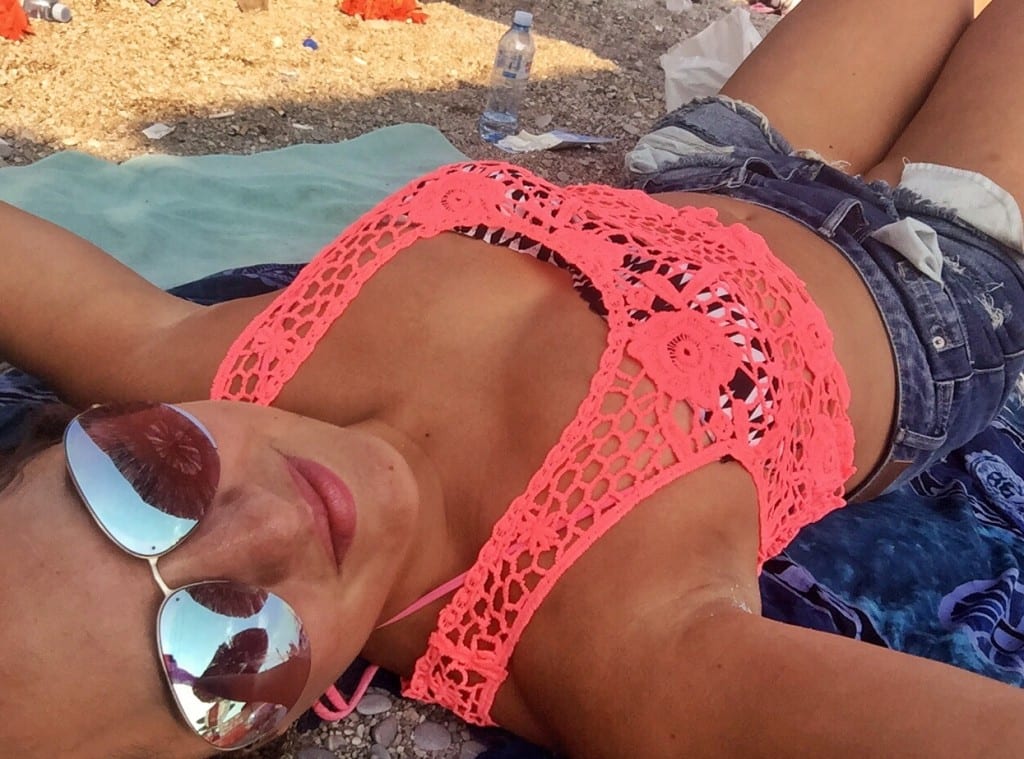
What to Pack for the Balkans
Packing for the Balkans depends on what time of year you’re visiting and what you plan to do on your trip. If you’re visiting beaches, you should bring a sarong; if you’re trekking, you might need good hiking gear. Here are some items that work well for most Balkans trips:
Pacsafe Travelsafe — It keeps your valuables locked up in your accommodation. I consider my portable safe the most important thing I pack.
Speakeasy Travel Supply scarf — These scarves are ideal for travel — they all have a hidden pocket for your passport or cash, and some come in light fabrics perfect for the Balkans. I love these scarves (I even designed my own!).
Water filter — If you’re visiting an area with questionable water safety, like Albania or rural parts of North Macedonia or Kosovo, bring a LifeStraw, a bottle that purifies water as you drink it through its straw. Alternatively, you can bring a reusable bottle and invest in a SteriPen water purifier (much better and faster than tablets).
Lockable backpack — If you’re planning on taking public transportation in the Balkans, using a small lockable backpack like my Pacsafe Venturesafe as your day bag is one way to protect yourself from pickpockets.
Sports sandals — Perfect footwear for climbing to the monastery in Kotor, exploring the Skocjan Caves in Slovenia, and walking the pathways at the Plitvice Lakes in Croatia. I’ve been wearing my Teva Tirra sandals since 2010.
Flip-flops — Essential beach footwear. I can’t wear most flip-flops due to arch issues but I ADORE my Abeo flip-flops with arch support.
Black flats — If you’re wearing dresses or wanting to look polished, I recommend the black Abeo flats from The Walking Company. They are insanely comfortable with great arch support.
Trail runners — If you plan to hike or work out in the Balkans, bring trail runners — they work equally well as sneakers and hiking shoes, as long as you’re not doing super-intense mountain hiking. I love my Merrill Siren Edge Q2 Waterproof Trail Runners.
Bathing suit — Even if you’re planning an urban getaway to the Balkans, you never know — there are more swimming opportunities than you think.
Divacup, if you menstruate — A great way to avoid buying pads and tampons and ultimately creating more waste in the Balkans.
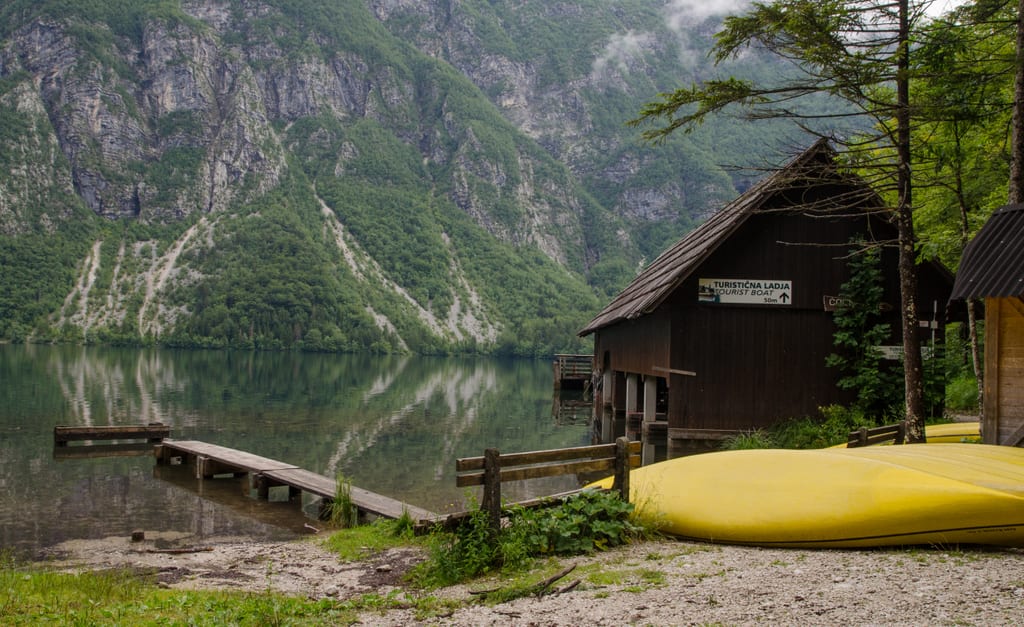
Travel Insurance for the Balkans
One last note — it’s absolutely vital to have travel insurance before traveling to the Balkans. If you get sick or injured on your trip, if you get robbed, or even if you have to be flown home for more care, travel insurance will protect you from financial ruin. I use and recommend World Nomads for trips to the Balkans.
Travel insurance will help you in your hour of need if you get pickpocketed on a bus ride to Skopje; they will help you get medical care if you come down with appendicitis in Lake Bled or trip and break an ankle while climbing the city walls in Dubrovnik; and if you get so sick that you need to be flown home for further care, like two of my friends have while traveling, they’ll cover the expensive flight.
As always, be sure to read your policy carefully and make sure it’s a fit for you. See what World Nomads covers here.

The Balkans are waiting for you!
The Balkans have meant SO much to me over the years. They’ve given me joy. They’ve brought me friends. They’ve helped me heal during tough times in my life, and they’ve helped me celebrate the best times of my life.
I will be traveling to the Balkans forever — and frankly, writing this post has made me realize how much I want to go back this summer! I’ll have to get on that. I hope you fall in love with this region as much as I have.
Go to the Balkans and have the time of your life. Then come back and tell me all about it.
This is a Solo Female Destination Guide.
Want more? See the guides for Croatia, Italy, Paris, and more!
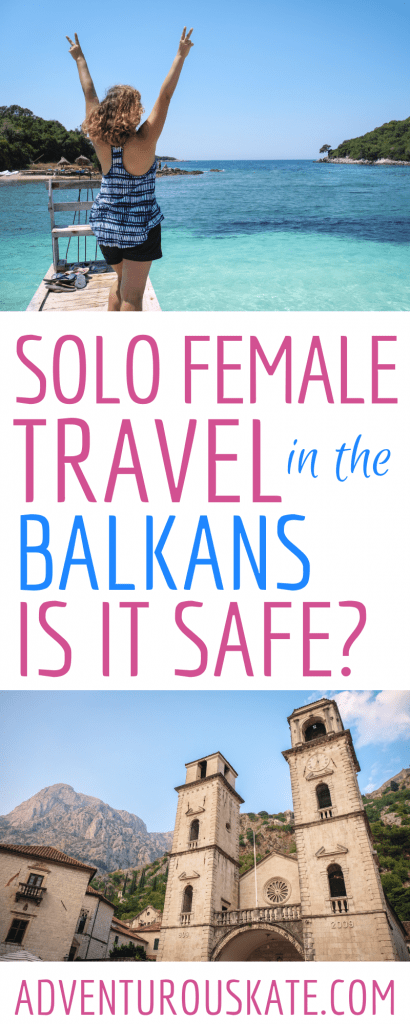
Have you traveled solo in the Balkans? Share your tips!